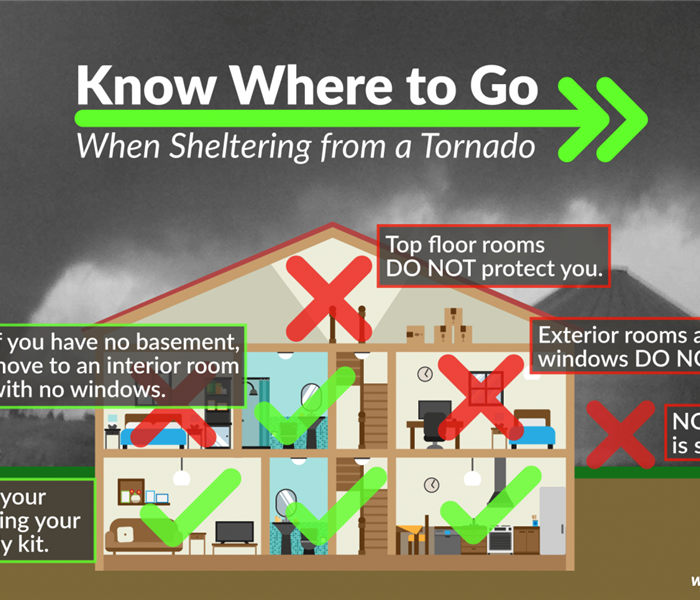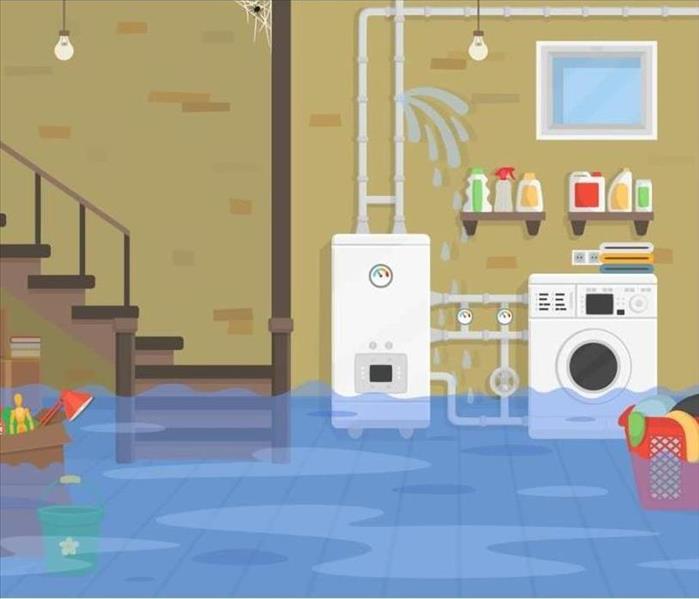Recent Storm Damage Posts
Tornado Safety
6/22/2023 (Permalink)
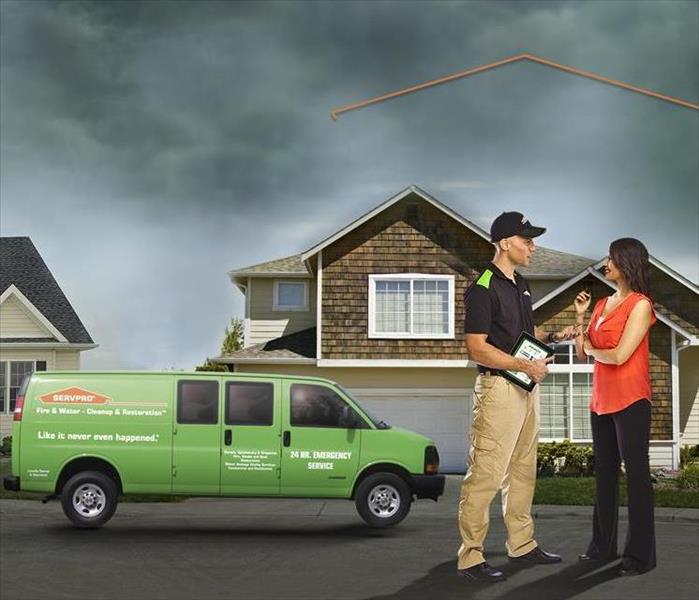 Storm
Storm
With all the crazy weather that hits the Midwest during the spring and summer seasons, it is always better to be prepared and know how to stay safe ahead of time. Below are some tips from the American Red Cross on the best ways to stay safe during a tornado.
Top Tips
Identify a safe place in your home where household members and pets will gather during a tornado: a basement, storm cellar or an interior room on the lowest floor with no windows.
In a high-rise building, pick a hallway in the center of the building. You may not have enough time to go to the lowest floor.
In a mobile home, choose a safe place in a nearby sturdy building. If your mobile home park has a designated shelter, make it your safe place. No mobile home, however it is configured, is safe in a tornado.
Know the Difference between a Tornado Watch and a Tornado Warning!
A tornado WATCH means a tornado is possible.
A tornado WARNING means a tornado is already occurring or will occur soon. GO TO YOUR SAFE PLACE IMMEDIATELY.
What To Do If Your Basement Floods
6/7/2023 (Permalink)
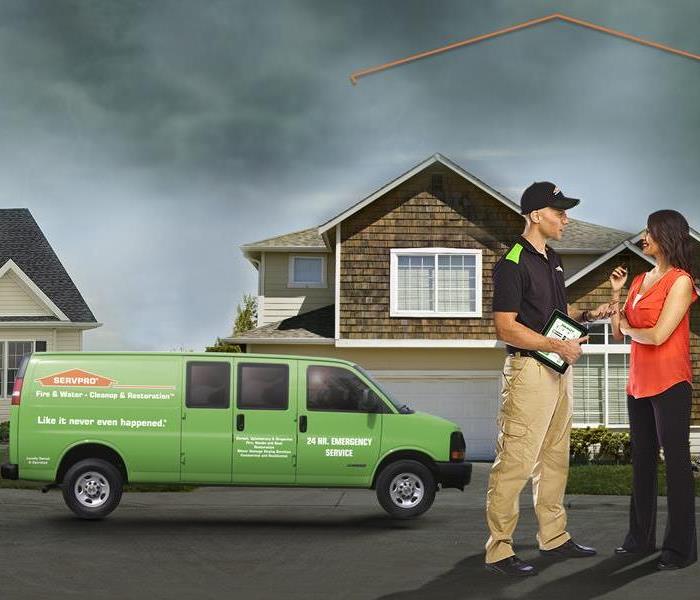 Storm
Storm
Midwest summer weather is hard to predict but you can usually bet on some weeks of rainy weather, ranging from drizzles to monsoons, and knowing how to speed up the drying process and keep your belongings safe from damage is a must!
First of all Safety First!
If there is standing water, or any water, in your basement make sure you are wearing some sort of foot gear that will protect your feet from getting soaked.
NEVER plug in any sort of equipment near water or in to a damp socket!
Protect Your Belongings!
It is always a good idea to have any boxes or contents in your basement off the floor and up on pallets at all times in case of a flooded basement but if you don't or if you have a finished basement one of the first things you will want to do is move all (or as much as you can) of your contents and furniture away from the affected area. If you cannot get furniture out of the area place it up on foam blocks or at least put some sort of non permeable barrier in between the furniture and floor to help prevent further damage and staining.
Beginning the Drying Process!
Using a shop-vac, plugged in to a power supply that has not been affected by the water, start to suck up the incoming water.
During normal conditions SERVPRO would happily perform all of the above for any homeowner but when extreme weather hits and thousands of people have flooded basements, we want to try and help as many people as we can. By performing the above tasks you can insure less loss until we can get there to help!
In Case of Emergency
5/28/2023 (Permalink)
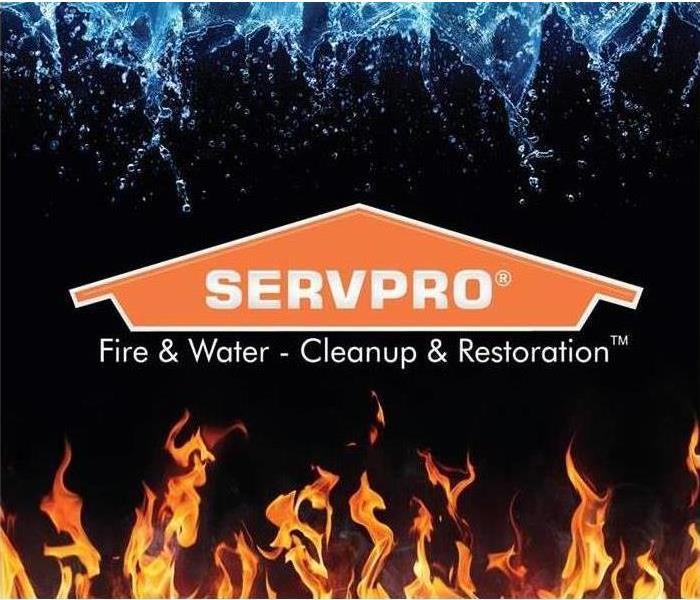 SERVPRO logo fire water
SERVPRO logo fire water
This page explains what actions to take when you receive a tornado watch or warning alert from the National Weather Service for your local area and what to do before, during, and after a tornado.
Know your risk
What
A tornado is a violently rotating column of air that extends from a thunderstorm to the ground and is often—although not always—visible as a funnel cloud. Lightning and hail are common in thunderstorms that produce tornadoes. Tornadoes cause extensive damage to structures and disrupt transportation, power, water, gas, communications, and other services in its direct path and in neighboring areas. Related thunderstorms can cause heavy rains, flash flooding, and hail
Where
About 1,200 tornadoes hit the United States every year and every state is at risk. Most tornadoes in the United States occur east of the Rocky Mountains with concentrations in the central and southern plains, the Gulf Coast and Florida.
When
Tornadoes can strike in any season, but occur most often in the spring and summer months. They can occur at all hours of the day and night, but are most likely to occur between 3 p.m. and 9 p.m.
Before a Tornado
Identify safe rooms built to FEMA criteria or ICC500 storm shelters or other potential protective locations in sturdy buildings near your home, work, and other locations you frequent so you have a plan for where you will go quickly for safety when there is a Warning or an approaching tornado.
For schools, malls, and other buildings with long-span roofs or open space plans, or many occupants, ask the building manager to identify the best available refuge.
Build an emergency kit and make a family communications plan.
Listen to NOAA Weather Radio or to commercial radio or television newscasts for the latest information. In any emergency, always listen to the instructions given by local emergency management officials.
Be alert to changing weather conditions. Look for approaching storms.
Look for the following danger signs:
Dark, often greenish sky
Large hail
A large, dark, low-lying cloud (particularly if rotating)
Loud roar, similar to a freight train.
If you see approaching storms or any of the danger signs, be prepared to take shelter immediately.
Tornado Facts
The extent of destruction caused by tornadoes depends on the tornado’s intensity, size, path, time of day, and amount of time it is on the ground. Wind from tornadoes can reach more than 300 miles per hour, and damage paths can be more than 1 mile wide and 50 miles long. Wind from tornadoes can destroy buildings and trees, transform debris into deadly projectiles, and roll vehicles.
They may strike quickly, with little or no warning.
They may appear nearly transparent until dust and debris are picked up or a cloud forms in the funnel.
The average tornado moves Southwest to Northeast, but tornadoes have been known to move in any direction.
Tornadoes can accompany tropical storms and hurricanes as they move onto land.
Waterspouts are tornadoes that form over water.
Know the Terms
Familiarize yourself with these terms to help identify a tornado hazard:
Tornado Watch - Tornadoes are possible. When there is a Watch, move to be near enough to a shelter or sturdy building to be able to get there quickly in a few minutes if there is a Warning or if you see signs of a tornado approaching. Remain alert for approaching storms. Watch the sky and stay tuned to NOAA Weather Radio, commercial radio or television for information.
Tornado Warning - A tornado has been sighted or indicated by weather radar. Take shelter immediately.
During a Tornado
If you are under a tornado warning, seek shelter immediately! Most injuries associated with high winds are from flying debris, so remember to protect your head.
If you are in school, nursing home, hospital, factory, shopping center, high-rise building pre-identified best available refuge then:
Go to a pre-designated area such as a safe room built to FEMA criteria, or a small interior windowless room on the lowest level, below ground in a basement, or storm cellar, is best. (Closet, interior hallway) away from corners, windows, doors, and outside walls. Put as many walls as possible between you and the outside. Get under a sturdy table and cover your head and neck with your arms and cover your body as best you can e.g., with a heavy coat or blankets, pillows. .
In a high-rise building, go to a small interior room or hallway on the lowest floor possible.
Do not open windows.
A sturdy structure (e.g. residence, small building) , school, nursing home, hospital, factory, shopping center, high-rise building)
A manufactured home or office then:
Get out immediately and go to a pre-identified location such as the lowest floor of a sturdy, nearby building or a storm shelter. Mobile homes, even if tied down, do not offer protection from tornadoes.
The outside with no shelter then:
If you are not in a sturdy building, there is no single research-based recommendation for what last-resort action to take because many factors can affect your decision. Possible actions include:
Immediately get into a vehicle, buckle your seat belt and try to drive to the closest sturdy shelter. If your vehicle is hit by flying debris while you are driving, pull over and park.
Take cover in a stationary vehicle. Put the seat belt on and cover your head with your arms and a blanket, coat or other cushion if possible.
In all situations:
Do not get under an overpass or bridge. You are safer in a low, flat location.
Never try to outrun a tornado in urban or congested areas in a car or truck. Instead, leave the vehicle immediately for protection in a sturdy building. .
Outdoor areas are not protected from flying debris. Flying debris from tornadoes causes most fatalities and injuries.
After a Tornado
If you are trapped, do not move about or kick up dust. Tap on a pipe or wall or use a whistle, if you have one, so that rescuers can locate you.
Listen to local officials for updates and instructions.
Check-in with family and friends by texting or using social media.
Watch out for debris and downed power lines.
Stay out of damaged buildings and homes until local authorities indicate it is safe.
Use extreme caution during post-disaster clean-up of buildings and around debris. Do not attempt to remove heavy debris by yourself. Wear protective clothing, including a long-sleeved shirt, long pants, work gloves, and sturdy, thick-soled shoes during clean-up.
Photograph the damage to your property in order to assist in filing an insurance claim.
Do what you can to prevent further damage to your property, (e.g., putting a tarp on a damaged roof), as insurance may not cover additional damage that occurs after the storm.
If your home is without power, use flashlights or battery-powered lanterns rather than candles to prevent accidental fires.
Kansas weather can be unpredictable! Be informed & stay safe!
If tragedy strikes remember, SERVPRO of West Topeka is always here to help!
785-862-0550
Storm Preparedness: Emergency Contacts
5/17/2023 (Permalink)
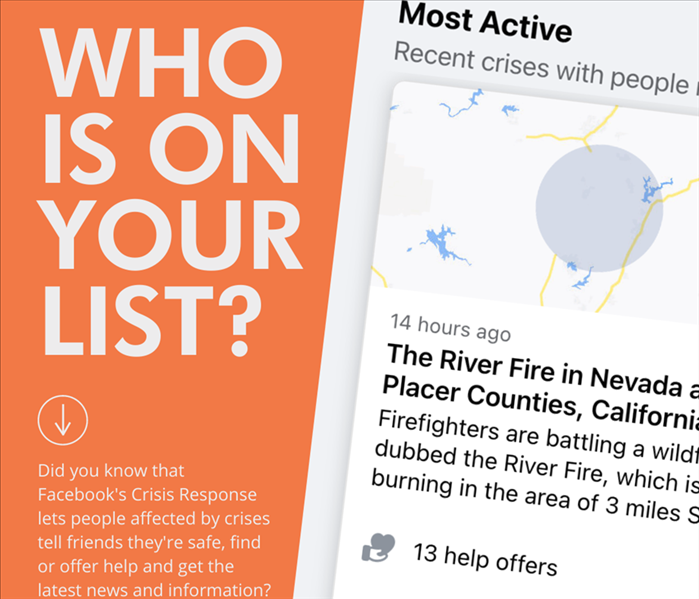 Storm Preparedness: Emergency Contacts
Storm Preparedness: Emergency Contacts
SERVPRO of West Topeka is always prepared in case of emergency. In order to be as prepared as possible, we have compiled several different check lists and make sure to check them twice! One list that is very important is the emergency contact list. Emergency contact lists that include friends, family, and neighbors are key to prepping for any disaster. Another great tool is Facebook. You may know how to mark yourself safe on the app after a crisis, but did you know you can REQUEST updates, too? See the link for more information! https://bddy.me/3yP3k5l
If you are in need of our services or have any questions please call us! We are open 24 hours a day, 7 days a week, 365 days a year!
Tornado Safety
6/15/2022 (Permalink)
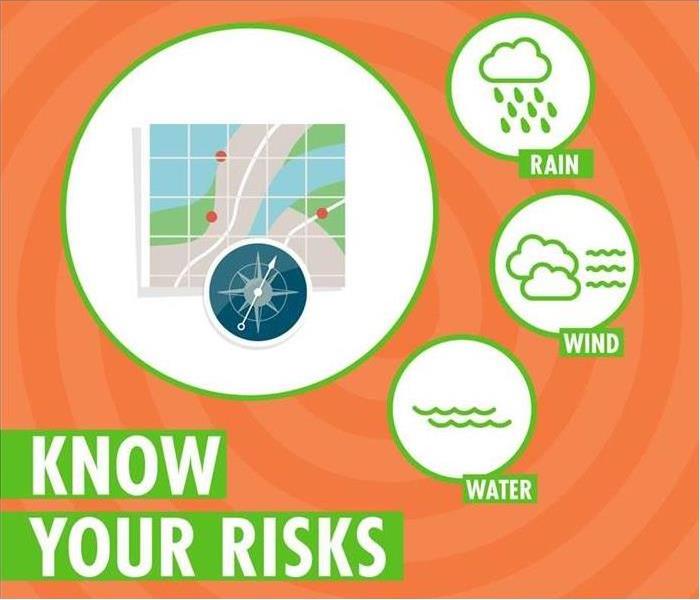 Tornado Safety
Tornado Safety
With all the crazy weather the Midwest has in the spring and summer, it is always better to be prepared and know how to stay safe ahead of time. Below are some tips from the American Red Cross on the best ways to stay safe during a tornado.
Top Tips
Identify a safe place in your home where household members and pets will gather during a tornado: a basement, storm cellar or an interior room on the lowest floor with no windows.
In a high-rise building, pick a hallway in the center of the building. You may not have enough time to go to the lowest floor.
In a mobile home, choose a safe place in a nearby sturdy building. If your mobile home park has a designated shelter, make it your safe place. No mobile home, however it is configured, is safe in a tornado.
Know the Difference between a Tornado Watch and a Tornado Warning!
A tornado WATCH means a tornado is possible.
A tornado WARNING means a tornado is already occurring or will occur soon. GO TO YOUR SAFE PLACE IMMEDIATELY.
What to do if your basement floods
6/10/2022 (Permalink)
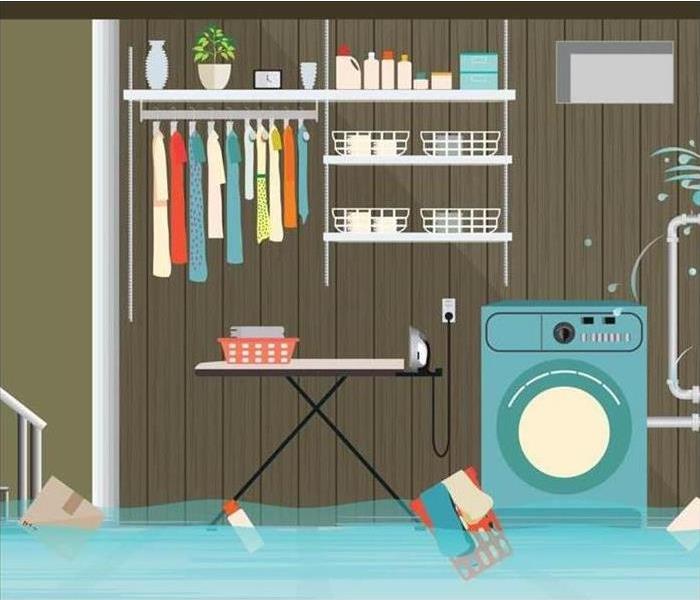 What to do if your basement floods
What to do if your basement floods
Midwest summer weather is hard to predict but you can usually bet on some weeks of rainy weather, ranging from drizzles to monsoons, and knowing how to speed up the drying process and keep your belongings safe from damage is a must!
First of all Safety First!
If there is standing water, or any water, in your basement make sure you are wearing some sort of foot gear that will protect your feet from getting soaked.
NEVER plug in any sort of equipment near water or in to a damp socket!
Protect Your Belongings!
It is always a good idea to have any boxes or contents in your basement off the floor and up on pallets at all times in case of a flooded basement but if you don't or if you have a finished basement one of the first things you will want to do is move all (or as much as you can) of your contents and furniture away from the affected area. If you cannot get furniture out of the area place it up on foam blocks or at least put some sort of non permeable barrier in between the furniture and floor to help prevent further damage and staining.
Beginning the Drying Process!
Using a shop vac, plugged in to a power supply that has not been affected by the water, start to suck up the incoming water.
During normal conditions SERVPRO would happily perform all of the above for any homeowner but when extreme weather hits and thousands of people have flooded basements, we want to try and help as many people as we can. By performing the above tasks you can insure less loss until we can get there to help!
In Case of Emergency
5/9/2022 (Permalink)
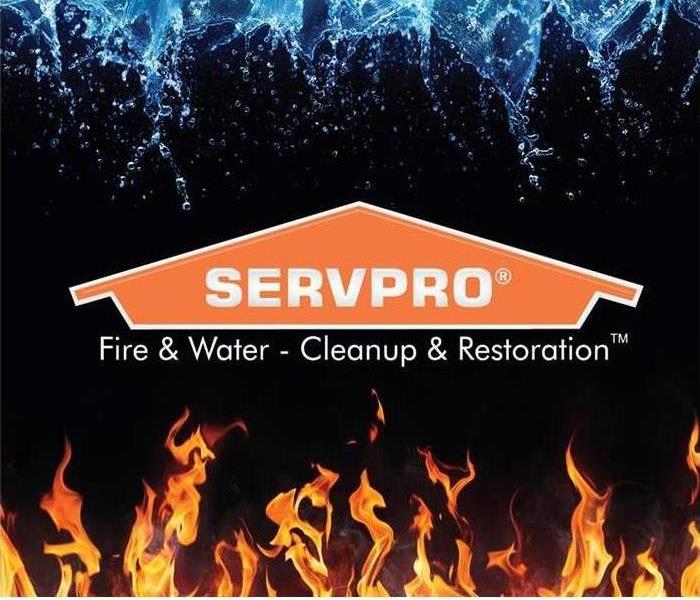 In case of Emergency
In case of Emergency
This page explains what actions to take when you receive a tornado watch or warning alert from the National Weather Service for your local area and what to do before, during, and after a tornado.
Know your risk
What
A tornado is a violently rotating column of air that extends from a thunderstorm to the ground and is often—although not always—visible as a funnel cloud. Lightning and hail are common in thunderstorms that produce tornadoes. Tornadoes cause extensive damage to structures and disrupt transportation, power, water, gas, communications, and other services in its direct path and in neighboring areas. Related thunderstorms can cause heavy rains, flash flooding, and hail
Where
About 1,200 tornadoes hit the United States every year and every state is at risk. Most tornadoes in the United States occur east of the Rocky Mountains with concentrations in the central and southern plains, the Gulf Coast and Florida.
When
Tornadoes can strike in any season, but occur most often in the spring and summer months. They can occur at all hours of the day and night, but are most likely to occur between 3 p.m. and 9 p.m.
Before a Tornado
Identify safe rooms built to FEMA criteria or ICC500 storm shelters or other potential protective locations in sturdy buildings near your home, work, and other locations you frequent so you have a plan for where you will go quickly for safety when there is a Warning or an approaching tornado.
For schools, malls, and other buildings with long-span roofs or open space plans, or many occupants, ask the building manager to identify the best available refuge.
Build an emergency kit and make a family communications plan.
Listen to NOAA Weather Radio or to commercial radio or television newscasts for the latest information. In any emergency, always listen to the instructions given by local emergency management officials.
Be alert to changing weather conditions. Look for approaching storms.
Look for the following danger signs:
Dark, often greenish sky
Large hail
A large, dark, low-lying cloud (particularly if rotating)
Loud roar, similar to a freight train.
If you see approaching storms or any of the danger signs, be prepared to take shelter immediately.
Tornado Facts
The extent of destruction caused by tornadoes depends on the tornado’s intensity, size, path, time of day, and amount of time it is on the ground. Wind from tornadoes can reach more than 300 miles per hour, and damage paths can be more than 1 mile wide and 50 miles long. Wind from tornadoes can destroy buildings and trees, transform debris into deadly projectiles, and roll vehicles.
They may strike quickly, with little or no warning.
They may appear nearly transparent until dust and debris are picked up or a cloud forms in the funnel.
The average tornado moves Southwest to Northeast, but tornadoes have been known to move in any direction.
Tornadoes can accompany tropical storms and hurricanes as they move onto land.
Waterspouts are tornadoes that form over water.
Know the Terms
Familiarize yourself with these terms to help identify a tornado hazard:
Tornado Watch - Tornadoes are possible. When there is a Watch, move to be near enough to a shelter or sturdy building to be able to get there quickly in a few minutes if there is a Warning or if you see signs of a tornado approaching. Remain alert for approaching storms. Watch the sky and stay tuned to NOAA Weather Radio, commercial radio or television for information.
Tornado Warning - A tornado has been sighted or indicated by weather radar. Take shelter immediately.
During a Tornado
If you are under a tornado warning, seek shelter immediately! Most injuries associated with high winds are from flying debris, so remember to protect your head.
If you are in school, nursing home, hospital, factory, shopping center, high-rise building pre-identified best available refuge then:
Go to a pre-designated area such as a safe room built to FEMA criteria, or a small interior windowless room on the lowest level, below ground in a basement, or storm cellar, is best. (Closet, interior hallway) away from corners, windows, doors, and outside walls. Put as many walls as possible between you and the outside. Get under a sturdy table and cover your head and neck with your arms and cover your body as best you can e.g., with a heavy coat or blankets, pillows. .
In a high-rise building, go to a small interior room or hallway on the lowest floor possible.
Do not open windows.
A sturdy structure (e.g. residence, small building) , school, nursing home, hospital, factory, shopping center, high-rise building)
A manufactured home or office then:
Get out immediately and go to a pre-identified location such as the lowest floor of a sturdy, nearby building or a storm shelter. Mobile homes, even if tied down, do not offer protection from tornadoes.
The outside with no shelter then:
If you are not in a sturdy building, there is no single research-based recommendation for what last-resort action to take because many factors can affect your decision. Possible actions include:
Immediately get into a vehicle, buckle your seat belt and try to drive to the closest sturdy shelter. If your vehicle is hit by flying debris while you are driving, pull over and park.
Take cover in a stationary vehicle. Put the seat belt on and cover your head with your arms and a blanket, coat or other cushion if possible.
In all situations:
Do not get under an overpass or bridge. You are safer in a low, flat location.
Never try to outrun a tornado in urban or congested areas in a car or truck. Instead, leave the vehicle immediately for protection in a sturdy building. .
Outdoor areas are not protected from flying debris. Flying debris from tornadoes causes most fatalities and injuries.
After a Tornado
If you are trapped, do not move about or kick up dust. Tap on a pipe or wall or use a whistle, if you have one, so that rescuers can locate you.
Listen to local officials for updates and instructions.
Check-in with family and friends by texting or using social media.
Watch out for debris and downed power lines.
Stay out of damaged buildings and homes until local authorities indicate it is safe.
Use extreme caution during post-disaster clean-up of buildings and around debris. Do not attempt to remove heavy debris by yourself. Wear protective clothing, including a long-sleeved shirt, long pants, work gloves, and sturdy, thick-soled shoes during clean-up.
Photograph the damage to your property in order to assist in filing an insurance claim.
Do what you can to prevent further damage to your property, (e.g., putting a tarp on a damaged roof), as insurance may not cover additional damage that occurs after the storm.
If your home is without power, use flashlights or battery-powered lanterns rather than candles to prevent accidental fires.
Kansas weather can be unpredictable! Be informed & stay safe!
If tragedy strikes remember, SERVPRO of West Topeka is always here to help!
785-862-0550
Tornadoes......Are you prepared?
5/9/2022 (Permalink)
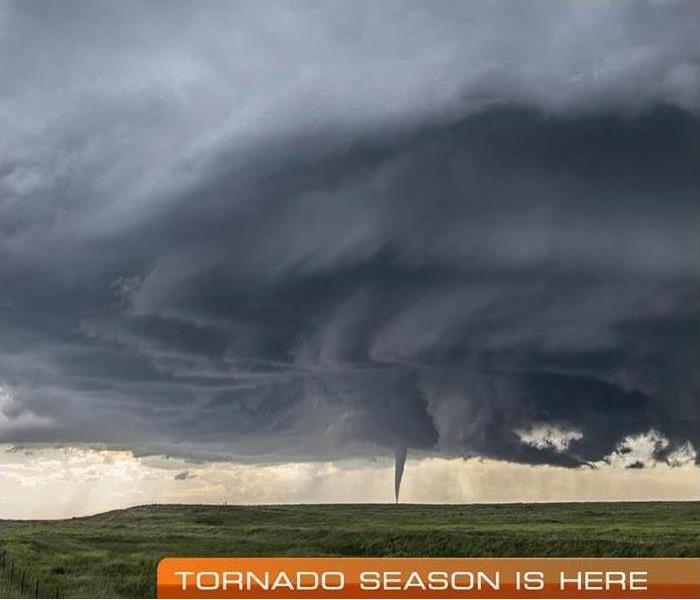 Tornadoes are you prepared
Tornadoes are you prepared
This page explains what actions to take when you receive a tornado watch or warning alert from the National Weather Service for your local area and what to do before, during, and after a tornado.
Know your risk
What
A tornado is a violently rotating column of air that extends from a thunderstorm to the ground and is often—although not always—visible as a funnel cloud. Lightning and hail are common in thunderstorms that produce tornadoes. Tornadoes cause extensive damage to structures and disrupt transportation, power, water, gas, communications, and other services in its direct path and in neighboring areas. Related thunderstorms can cause heavy rains, flash flooding, and hail
Where
About 1,200 tornadoes hit the United States every year and every state is at risk. Most tornadoes in the United States occur east of the Rocky Mountains with concentrations in the central and southern plains, the Gulf Coast and Florida.
When
Tornadoes can strike in any season, but occur most often in the spring and summer months. They can occur at all hours of the day and night, but are most likely to occur between 3 p.m. and 9 p.m.
Before a Tornado
- Identify safe rooms built to FEMA criteria or ICC500 storm shelters or other potential protective locations in sturdy buildings near your home, work, and other locations you frequent so you have a plan for where you will go quickly for safety when there is a Warning or an approaching tornado.
- For schools, malls, and other buildings with long-span roofs or open space plans, or many occupants, ask the building manager to identify the best available refuge.
- Build an emergency kit and make a family communications plan.
- Listen to NOAA Weather Radio or to commercial radio or television newscasts for the latest information. In any emergency, always listen to the instructions given by local emergency management officials.
- Be alert to changing weather conditions. Look for approaching storms.
- Look for the following danger signs:
- Dark, often greenish sky
- Large hail
- A large, dark, low-lying cloud (particularly if rotating)
- Loud roar, similar to a freight train.
- If you see approaching storms or any of the danger signs, be prepared to take shelter immediately.
Tornado Facts
The extent of destruction caused by tornadoes depends on the tornado’s intensity, size, path, time of day, and amount of time it is on the ground. Wind from tornadoes can reach more than 300 miles per hour, and damage paths can be more than 1 mile wide and 50 miles long. Wind from tornadoes can destroy buildings and trees, transform debris into deadly projectiles, and roll vehicles.
- They may strike quickly, with little or no warning.
- They may appear nearly transparent until dust and debris are picked up or a cloud forms in the funnel.
- The average tornado moves Southwest to Northeast, but tornadoes have been known to move in any direction.
- Tornadoes can accompany tropical storms and hurricanes as they move onto land.
- Waterspouts are tornadoes that form over water.
Know the Terms
Familiarize yourself with these terms to help identify a tornado hazard:
- Tornado Watch - Tornadoes are possible. When there is a Watch, move to be near enough to a shelter or sturdy building to be able to get there quickly in a few minutes if there is a Warning or if you see signs of a tornado approaching. Remain alert for approaching storms. Watch the sky and stay tuned to NOAA Weather Radio, commercial radio or television for information.
- Tornado Warning - A tornado has been sighted or indicated by weather radar. Take shelter immediately.
During a Tornado
If you are under a tornado warning, seek shelter immediately! Most injuries associated with high winds are from flying debris, so remember to protect your head.
If you are in school, nursing home, hospital, factory, shopping center, high-rise building pre-identified best available refuge then:
- Go to a pre-designated area such as a safe room built to FEMA criteria, or a small interior windowless room on the lowest level, below ground in a basement, or storm cellar, is best. (Closet, interior hallway) away from corners, windows, doors, and outside walls. Put as many walls as possible between you and the outside. Get under a sturdy table and cover your head and neck with your arms and cover your body as best you can e.g., with a heavy coat or blankets, pillows. .
- In a high-rise building, go to a small interior room or hallway on the lowest floor possible.
- Do not open windows.
- A sturdy structure (e.g. residence, small building) , school, nursing home, hospital, factory, shopping center, high-rise building)
A manufactured home or office then:
Get out immediately and go to a pre-identified location such as the lowest floor of a sturdy, nearby building or a storm shelter. Mobile homes, even if tied down, do not offer protection from tornadoes.
The outside with no shelter then:
- If you are not in a sturdy building, there is no single research-based recommendation for what last-resort action to take because many factors can affect your decision. Possible actions include:
- Immediately get into a vehicle, buckle your seat belt and try to drive to the closest sturdy shelter. If your vehicle is hit by flying debris while you are driving, pull over and park.
- Take cover in a stationary vehicle. Put the seat belt on and cover your head with your arms and a blanket, coat or other cushion if possible.
- In all situations:
- Do not get under an overpass or bridge. You are safer in a low, flat location.
- Never try to outrun a tornado in urban or congested areas in a car or truck. Instead, leave the vehicle immediately for protection in a sturdy building. .
- Outdoor areas are not protected from flying debris. Flying debris from tornadoes causes most fatalities and injuries.
After a Tornado
- If you are trapped, do not move about or kick up dust. Tap on a pipe or wall or use a whistle, if you have one, so that rescuers can locate you.
- Listen to local officials for updates and instructions.
- Check-in with family and friends by texting or using social media.
- Watch out for debris and downed power lines.
- Stay out of damaged buildings and homes until local authorities indicate it is safe.
- Use extreme caution during post-disaster clean-up of buildings and around debris. Do not attempt to remove heavy debris by yourself. Wear protective clothing, including a long-sleeved shirt, long pants, work gloves, and sturdy, thick-soled shoes during clean-up.
- Photograph the damage to your property in order to assist in filing an insurance claim.
- Do what you can to prevent further damage to your property, (e.g., putting a tarp on a damaged roof), as insurance may not cover additional damage that occurs after the storm.
- If your home is without power, use flashlights or battery-powered lanterns rather than candles to prevent accidental fires.
Kansas weather can be unpredictable! Be informed & stay safe!
If tragedy strikes remember, SERVPRO of W. Topeka is always here to help!
785-862-0550
Hazards of water damage
4/21/2022 (Permalink)
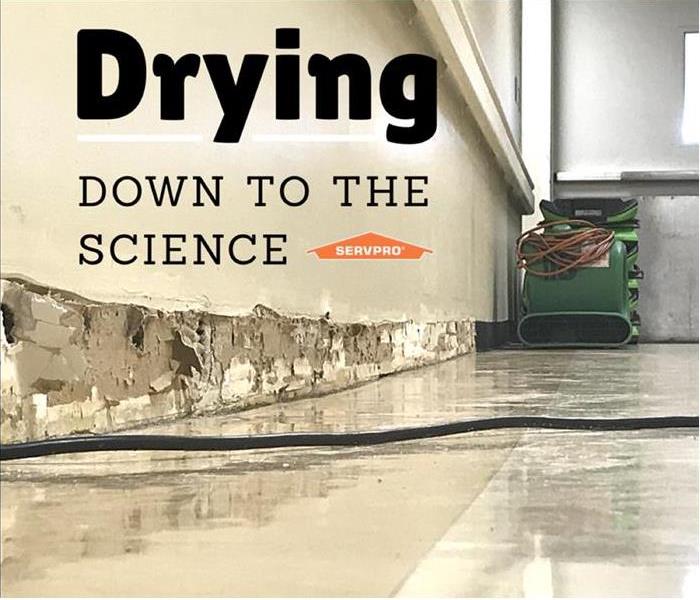 Hazards of water damage
Hazards of water damage
SERVPRO of West Topeka knows that in these uncertain times some things always remain the same. And one of those things is unexpected damage to your home. And whether that damage is from a rain storm, a tornado, or a broken refrigerator line, SERVPRO of West Topeka is here to help! If you experience a water loss or a flood, one of the most important things you can do is to identify potential hazards as soon as possible.
Here are a few to remember:
Ceiling: If water damage has occurred to your roof/ceiling, the ceiling/roof could potentially be unstable
Electrical shock hazards: Lights can indicate if the power is still on and if the area is dangerous. DO NOT touch any sockets or switches to check if the lights are on.
A 24/7 disaster recovery business
12/22/2021 (Permalink)
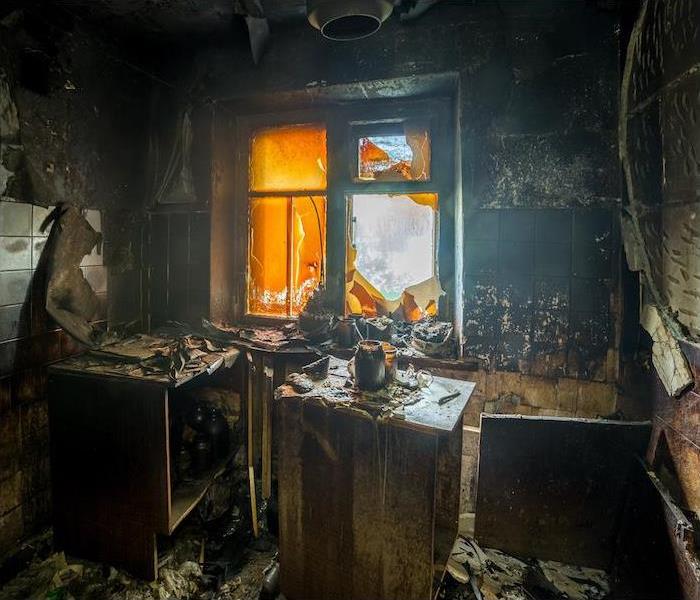 A 24/7 disaster recovery business
A 24/7 disaster recovery business
It makes sense for some businesses and service providers to keep business hours—it lets you know when they’ll be available to serve you, and in turn, they only have to operate during times when their service is likely to be needed. Makes perfect sense, most of the time.
But home disasters aren’t predictable—they can pop up anytime a pipe decides to burst or a destructive storm forms from thin air. In those cases, office hours aren’t nearly as helpful, because between the time one business day ends and the next begins, there’s a whopping 16 hours—that’s the majority of the day!
SERVPRO of West Topeka knows you can’t predict a disaster scenario. That’s why you never have to wait when you have an emergency—you can reach our helpful teams 24 hours a day to get the process of cleanup and recovery underway.
When you have to wait, bad things happen.
After a fire. The opening salvo for a fire is a flaming tower, but that’s not the end of things. Soot and smoke take only minutes to settle into walls, ceilings, and—you’d better believe—carpets.
As minutes turn to hours, the black slime they produce and smell they leave become permanent parts of your home’s landscape, meaning extra time and money have to be invested in reconstructing the surfaces they ruin.
After water damage. Once your home encounters water damage, a stopwatch starts ticking, and when it counts up to 48 hours, you have a mold issue on top of your initial water damage.
Mold growth physically threatens all kinds of organic surfaces in your home and on your possessions, and if left unmitigated it also becomes a rather serious threat to your health, especially if anyone in the home has pre-existing issues with asthma or respiratory difficulty.
And that’s just touching the surface. Flooding, natural disasters and powerful storms can make for sudden scenarios in which you need immediate help—and none of them pay attention to office hours. Fortunately, you’re linked up with the best team in the industry, right here in the neighborhood.
You don’t have to wait when you have a disaster at home. There’s a PRO for that.
When you need help after a home or business disaster, fast service is a priority, and there’s nobody faster or more prepared than SERVPRO. Call us anytime to take advantage of our 24-hour emergency service.
Storm Preparedness: Emergency Contacts
12/8/2021 (Permalink)
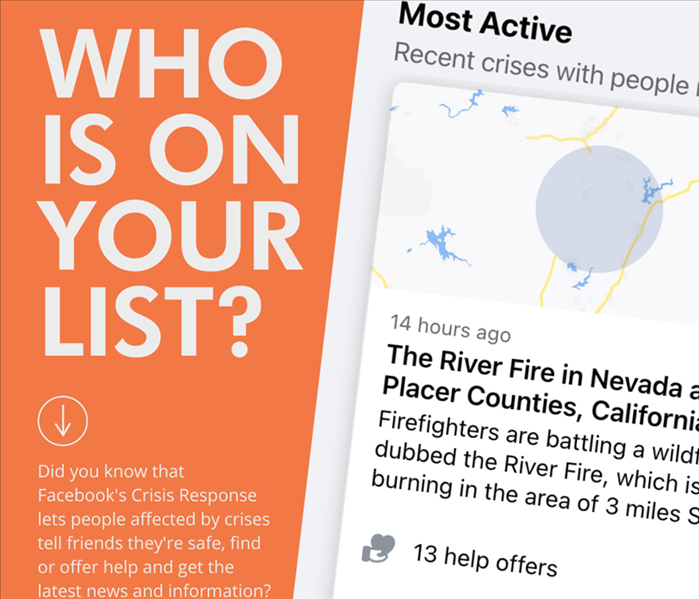 Storm Preparedness: Emergency Contacts
Storm Preparedness: Emergency Contacts
SERVPRO of West Topeka is always prepared in case of emergency. In order to be as prepared as possible, we have compiled several different check lists and make sure to check them twice! One list that is very important is the emergency contact list. Emergency contact lists that include friends, family, and neighbors are key to prepping for any disaster. Another great tool is Facebook. You may know how to mark yourself safe on the app after a crisis, but did you know you can REQUEST updates, too? See the link for more information! https://bddy.me/3yP3k5l
If you are in need of our services or have any questions please call us! We are open 24 hours a day, 7 days a week, 365 days a year!
Tornado Safety
6/9/2021 (Permalink)
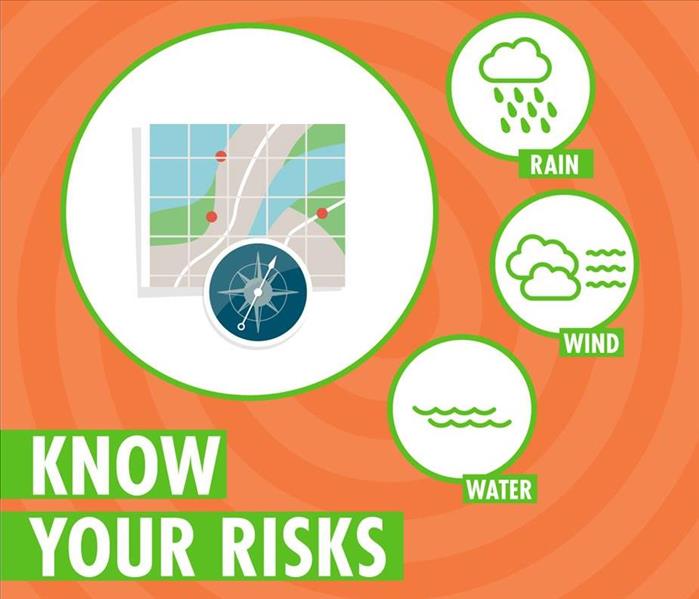 Tornado Safety
Tornado Safety
With all the crazy weather the Midwest has in the spring and summer, it is always better to be prepared and know how to stay safe ahead of time. Below are some tips from the American Red Cross on the best ways to stay safe during a tornado.
Top Tips
Identify a safe place in your home where household members and pets will gather during a tornado: a basement, storm cellar or an interior room on the lowest floor with no windows.
In a high-rise building, pick a hallway in the center of the building. You may not have enough time to go to the lowest floor.
In a mobile home, choose a safe place in a nearby sturdy building. If your mobile home park has a designated shelter, make it your safe place. No mobile home, however it is configured, is safe in a tornado.
Know the Difference between a Tornado Watch and a Tornado Warning!
A tornado WATCH means a tornado is possible.
A tornado WARNING means a tornado is already occurring or will occur soon. GO TO YOUR SAFE PLACE IMMEDIATELY.
What to do if your basement floods
6/7/2021 (Permalink)
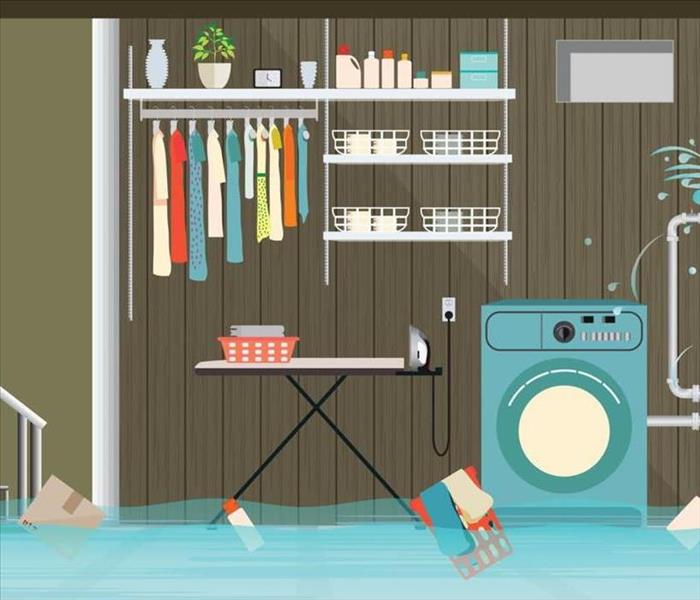 What to do if your basement floods
What to do if your basement floods
Midwest summer weather is hard to predict but you can usually bet on some weeks of rainy weather, ranging from drizzles to monsoons, and knowing how to speed up the drying process and keep your belongings safe from damage is a must!
First of all Safety First!
If there is standing water, or any water, in your basement make sure you are wearing some sort of foot gear that will protect your feet from getting soaked.
NEVER plug in any sort of equipment near water or in to a damp socket!
Protect Your Belongings!
It is always a good idea to have any boxes or contents in your basement off the floor and up on pallets at all times in case of a flooded basement but if you don't or if you have a finished basement one of the first things you will want to do is move all (or as much as you can) of your contents and furniture away from the affected area. If you cannot get furniture out of the area place it up on foam blocks or at least put some sort of non permeable barrier in between the furniture and floor to help prevent further damage and staining.
Beginning the Drying Process!
Using a shop vac, plugged in to a power supply that has not been affected by the water, start to suck up the incoming water.
During normal conditions SERVPRO would happily perform all of the above for any homeowner but when extreme weather hits and thousands of people have flooded basements, we want to try and help as many people as we can. By performing the above tasks you can insure less loss until we can get there to help!
Tornado Preparedness
5/11/2021 (Permalink)
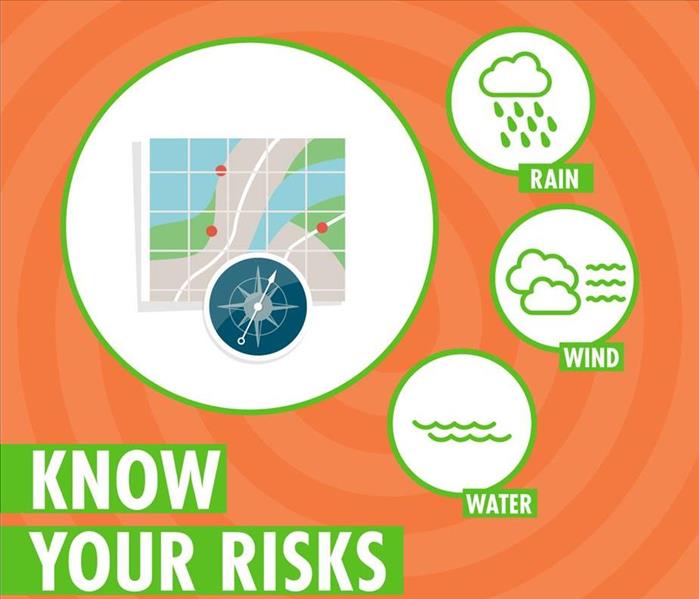 Tornado Preparedness
Tornado Preparedness
Tornado and Hurricane Preparedeness Week begins today and SERVPRO of West Topeka is sharing tips to help you get ready!
Start by creating an emergency plan for your family that includes emergency meeting places in your home, neighborhood, and outside your neighborhood. Create a plan here-> https://bddy.me/2Q3gjA6
Another important preparedness step is having an emergency kit at work, in your car, and at home. This could include a backpack, water, nonperishable food, a blanket, etc.
Another good step is reviewing your insurance. Look at your policies ahead of time to see what's covered and if flood insurance is available to you since it's the leading cause of damage from tropical systems.
If you do have damage from a storm event call SERVPRO of West Topeka and we will get you taken care of.
In case of emergency...
5/3/2021 (Permalink)
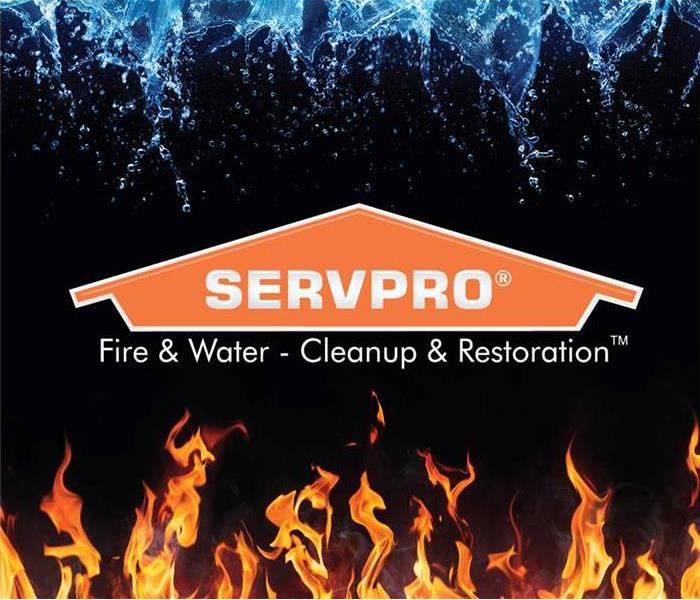 In case of emergency...
In case of emergency...
This page explains what actions to take when you receive a tornado watch or warning alert from the National Weather Service for your local area and what to do before, during, and after a tornado.
Know your risk
What
A tornado is a violently rotating column of air that extends from a thunderstorm to the ground and is often—although not always—visible as a funnel cloud. Lightning and hail are common in thunderstorms that produce tornadoes. Tornadoes cause extensive damage to structures and disrupt transportation, power, water, gas, communications, and other services in its direct path and in neighboring areas. Related thunderstorms can cause heavy rains, flash flooding, and hail
Where
About 1,200 tornadoes hit the United States every year and every state is at risk. Most tornadoes in the United States occur east of the Rocky Mountains with concentrations in the central and southern plains, the Gulf Coast and Florida.
When
Tornadoes can strike in any season, but occur most often in the spring and summer months. They can occur at all hours of the day and night, but are most likely to occur between 3 p.m. and 9 p.m.
Before a Tornado
Identify safe rooms built to FEMA criteria or ICC500 storm shelters or other potential protective locations in sturdy buildings near your home, work, and other locations you frequent so you have a plan for where you will go quickly for safety when there is a Warning or an approaching tornado.
For schools, malls, and other buildings with long-span roofs or open space plans, or many occupants, ask the building manager to identify the best available refuge.
Build an emergency kit and make a family communications plan.
Listen to NOAA Weather Radio or to commercial radio or television newscasts for the latest information. In any emergency, always listen to the instructions given by local emergency management officials.
Be alert to changing weather conditions. Look for approaching storms.
Look for the following danger signs:
Dark, often greenish sky
Large hail
A large, dark, low-lying cloud (particularly if rotating)
Loud roar, similar to a freight train.
If you see approaching storms or any of the danger signs, be prepared to take shelter immediately.
Tornado Facts
The extent of destruction caused by tornadoes depends on the tornado’s intensity, size, path, time of day, and amount of time it is on the ground. Wind from tornadoes can reach more than 300 miles per hour, and damage paths can be more than 1 mile wide and 50 miles long. Wind from tornadoes can destroy buildings and trees, transform debris into deadly projectiles, and roll vehicles.
They may strike quickly, with little or no warning.
They may appear nearly transparent until dust and debris are picked up or a cloud forms in the funnel.
The average tornado moves Southwest to Northeast, but tornadoes have been known to move in any direction.
Tornadoes can accompany tropical storms and hurricanes as they move onto land.
Waterspouts are tornadoes that form over water.
Know the Terms
Familiarize yourself with these terms to help identify a tornado hazard:
Tornado Watch - Tornadoes are possible. When there is a Watch, move to be near enough to a shelter or sturdy building to be able to get there quickly in a few minutes if there is a Warning or if you see signs of a tornado approaching. Remain alert for approaching storms. Watch the sky and stay tuned to NOAA Weather Radio, commercial radio or television for information.
Tornado Warning - A tornado has been sighted or indicated by weather radar. Take shelter immediately.
During a Tornado
If you are under a tornado warning, seek shelter immediately! Most injuries associated with high winds are from flying debris, so remember to protect your head.
If you are in school, nursing home, hospital, factory, shopping center, high-rise building pre-identified best available refuge then:
Go to a pre-designated area such as a safe room built to FEMA criteria, or a small interior windowless room on the lowest level, below ground in a basement, or storm cellar, is best. (Closet, interior hallway) away from corners, windows, doors, and outside walls. Put as many walls as possible between you and the outside. Get under a sturdy table and cover your head and neck with your arms and cover your body as best you can e.g., with a heavy coat or blankets, pillows. .
In a high-rise building, go to a small interior room or hallway on the lowest floor possible.
Do not open windows.
A sturdy structure (e.g. residence, small building) , school, nursing home, hospital, factory, shopping center, high-rise building)
A manufactured home or office then:
Get out immediately and go to a pre-identified location such as the lowest floor of a sturdy, nearby building or a storm shelter. Mobile homes, even if tied down, do not offer protection from tornadoes.
The outside with no shelter then:
If you are not in a sturdy building, there is no single research-based recommendation for what last-resort action to take because many factors can affect your decision. Possible actions include:
Immediately get into a vehicle, buckle your seat belt and try to drive to the closest sturdy shelter. If your vehicle is hit by flying debris while you are driving, pull over and park.
Take cover in a stationary vehicle. Put the seat belt on and cover your head with your arms and a blanket, coat or other cushion if possible.
In all situations:
Do not get under an overpass or bridge. You are safer in a low, flat location.
Never try to outrun a tornado in urban or congested areas in a car or truck. Instead, leave the vehicle immediately for protection in a sturdy building. .
Outdoor areas are not protected from flying debris. Flying debris from tornadoes causes most fatalities and injuries.
After a Tornado
If you are trapped, do not move about or kick up dust. Tap on a pipe or wall or use a whistle, if you have one, so that rescuers can locate you.
Listen to local officials for updates and instructions.
Check-in with family and friends by texting or using social media.
Watch out for debris and downed power lines.
Stay out of damaged buildings and homes until local authorities indicate it is safe.
Use extreme caution during post-disaster clean-up of buildings and around debris. Do not attempt to remove heavy debris by yourself. Wear protective clothing, including a long-sleeved shirt, long pants, work gloves, and sturdy, thick-soled shoes during clean-up.
Photograph the damage to your property in order to assist in filing an insurance claim.
Do what you can to prevent further damage to your property, (e.g., putting a tarp on a damaged roof), as insurance may not cover additional damage that occurs after the storm.
If your home is without power, use flashlights or battery-powered lanterns rather than candles to prevent accidental fires.
Kansas weather can be unpredictable! Be informed & stay safe!
If tragedy strikes remember, SERVPRO of West Topeka is always here to help!
785-862-0550
Preparing for Tornado Season
4/25/2021 (Permalink)
 Preparing for Tornado Season
Preparing for Tornado Season
This page explains what actions to take when you receive a tornado watch or warning alert from the National Weather Service for your local area and what to do before, during, and after a tornado.
What is a tornado?
A tornado is a violently rotating column of air that extends from a thunderstorm to the ground and is often—although not always—visible as a funnel cloud. Lightning and hail are common in thunderstorms that produce tornadoes. Tornadoes cause extensive damage to structures and disrupt transportation, power, water, gas, communications, and other services in its direct path and in neighboring areas. Related thunderstorms can cause heavy rains, flash flooding, and hail
Where
About 1,200 tornadoes hit the United States every year and every state is at risk. Most tornadoes in the United States occur east of the Rocky Mountains with concentrations in the central and southern plains, the Gulf Coast and Florida.
When
Tornadoes can strike in any season, but occur most often in the spring and summer months. They can occur at all hours of the day and night, but are most likely to occur between 3 p.m. and 9 p.m.
Before a Tornado
Identify safe rooms built to FEMA criteria or ICC500 storm shelters or other potential protective locations in sturdy buildings near your home, work, and other locations you frequent so you have a plan for where you will go quickly for safety when there is a Warning or an approaching tornado.
For schools, malls, and other buildings with long-span roofs or open space plans, or many occupants, ask the building manager to identify the best available refuge.
Build an emergency kit and make a family communications plan.
Listen to NOAA Weather Radio or to commercial radio or television newscasts for the latest information. In any emergency, always listen to the instructions given by local emergency management officials.
Be alert to changing weather conditions. Look for approaching storms.
Look for the following danger signs:
Dark, often greenish sky
Large hail
A large, dark, low-lying cloud (particularly if rotating)
Loud roar, similar to a freight train.
If you see approaching storms or any of the danger signs, be prepared to take shelter immediately.
Tornado Facts
The extent of destruction caused by tornadoes depends on the tornado’s intensity, size, path, time of day, and amount of time it is on the ground. Wind from tornadoes can reach more than 300 miles per hour, and damage paths can be more than 1 mile wide and 50 miles long. Wind from tornadoes can destroy buildings and trees, transform debris into deadly projectiles, and roll vehicles.
They may strike quickly, with little or no warning.
They may appear nearly transparent until dust and debris are picked up or a cloud forms in the funnel.
The average tornado moves Southwest to Northeast, but tornadoes have been known to move in any direction.
Tornadoes can accompany tropical storms and hurricanes as they move onto land.
Waterspouts are tornadoes that form over water.
Know the Terms
Familiarize yourself with these terms to help identify a tornado hazard:
Tornado Watch - Tornadoes are possible. When there is a Watch, move to be near enough to a shelter or sturdy building to be able to get there quickly in a few minutes if there is a Warning or if you see signs of a tornado approaching. Remain alert for approaching storms. Watch the sky and stay tuned to NOAA Weather Radio, commercial radio or television for information.
Tornado Warning - A tornado has been sighted or indicated by weather radar. Take shelter immediately.
During a Tornado
If you are under a tornado warning, seek shelter immediately! Most injuries associated with high winds are from flying debris, so remember to protect your head.
If you are in school, nursing home, hospital, factory, shopping center, high-rise building pre-identified best available refuge then:
Go to a pre-designated area such as a safe room built to FEMA criteria, or a small interior windowless room on the lowest level, below ground in a basement, or storm cellar, is best. (Closet, interior hallway) away from corners, windows, doors, and outside walls. Put as many walls as possible between you and the outside. Get under a sturdy table and cover your head and neck with your arms and cover your body as best you can e.g., with a heavy coat or blankets, pillows. .
In a high-rise building, go to a small interior room or hallway on the lowest floor possible.
Do not open windows.
A sturdy structure (e.g. residence, small building) , school, nursing home, hospital, factory, shopping center, high-rise building)
A manufactured home or office then:
Get out immediately and go to a pre-identified location such as the lowest floor of a sturdy, nearby building or a storm shelter. Mobile homes, even if tied down, do not offer protection from tornadoes.
The outside with no shelter then:
If you are not in a sturdy building, there is no single research-based recommendation for what last-resort action to take because many factors can affect your decision. Possible actions include:
Immediately get into a vehicle, buckle your seat belt and try to drive to the closest sturdy shelter. If your vehicle is hit by flying debris while you are driving, pull over and park.
Take cover in a stationary vehicle. Put the seat belt on and cover your head with your arms and a blanket, coat or other cushion if possible.
In all situations:
Do not get under an overpass or bridge. You are safer in a low, flat location.
Never try to outrun a tornado in urban or congested areas in a car or truck. Instead, leave the vehicle immediately for protection in a sturdy building. .
Outdoor areas are not protected from flying debris. Flying debris from tornadoes causes most fatalities and injuries.
After a Tornado
If you are trapped, do not move about or kick up dust. Tap on a pipe or wall or use a whistle, if you have one, so that rescuers can locate you.
Listen to local officials for updates and instructions.
Check-in with family and friends by texting or using social media.
Watch out for debris and downed power lines.
Stay out of damaged buildings and homes until local authorities indicate it is safe.
Use extreme caution during post-disaster clean-up of buildings and around debris. Do not attempt to remove heavy debris by yourself. Wear protective clothing, including a long-sleeved shirt, long pants, work gloves, and sturdy, thick-soled shoes during clean-up.
Photograph the damage to your property in order to assist in filing an insurance claim.
Do what you can to prevent further damage to your property, (e.g., putting a tarp on a damaged roof), as insurance may not cover additional damage that occurs after the storm.
If your home is without power, use flashlights or battery-powered lanterns rather than candles to prevent accidental fires.
Kansas weather can be unpredictable! Be informed & stay safe!
If tragedy strikes remember, SERVPRO of West Topeka is always here to help!
785-862-0550
What to do if you have a water damage
4/20/2021 (Permalink)
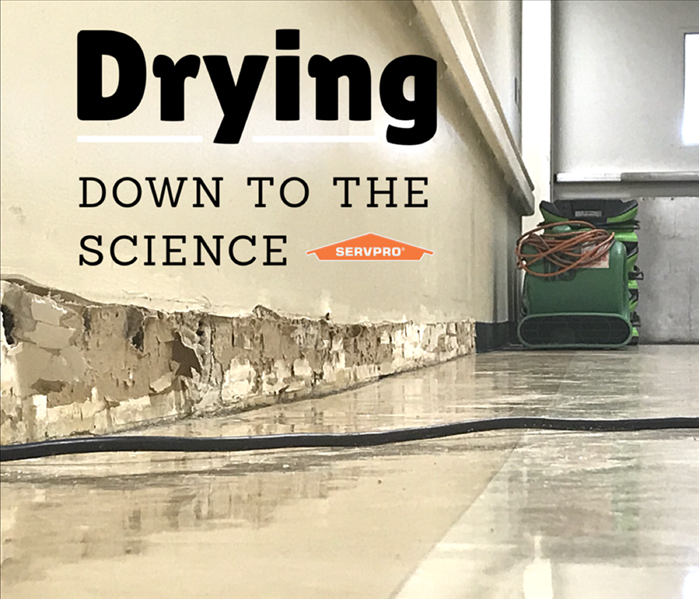 What to do if you have a water damage
What to do if you have a water damage
SERVPRO of West Topeka knows that in these uncertain times some things always remain the same. And one of those things is unexpected damage to your home. And whether that damage is from a rain storm, a tornado, or a broken refrigerator line, SERVPRO of West Topeka is here to help! If you experience a water loss or a flood, one of the most important things you can do is to identify potential hazards as soon as possible.
Here are a few to remember:
Ceiling: If water damage has occurred to your roof/ceiling, the ceiling/roof could potentially be unstable
Electrical shock hazards: Lights can indicate if the power is still on and if the area is dangerous. DO NOT touch any sockets or switches to check if the lights are on.
The first steps to any water damage...
6/4/2020 (Permalink)
 The first steps to any water damage...
The first steps to any water damage...
Midwest summer weather is hard to predict but you can usually bet on some weeks of rainy weather, ranging from drizzles to monsoons, and knowing how to speed up the drying process and keep your belongings safe from damage is a must!
First of all Safety First!
If there is standing water, or any water, in your basement make sure you are wearing some sort of foot gear that will protect your feet from getting soaked.
NEVER plug in any sort of equipment near water or in to a damp socket!
Protect Your Belongings!
It is always a good idea to have any boxes or contents in your basement off the floor and up on pallets at all times in case of a flooded basement but if you don't or if you have a finished basement one of the first things you will want to do is move all (or as much as you can) of your contents and furniture away from the affected area. If you cannot get furniture out of the area place it up on foam blocks or at least put some sort of non permeable barrier in between the furniture and floor to help prevent further damage and staining.
Beginning the Drying Process!
Using a shop vac, plugged in to a power supply that has not been affected by the water, start to suck up the incoming water.
During normal conditions SERVPRO would happily perform all of the above for any homeowner but when extreme weather hits and thousands of people have flooded basements, we want to try and help as many people as we can. By performing the above tasks you can insure less loss until we can get there to help!
Staying safe during a tornado
6/4/2020 (Permalink)
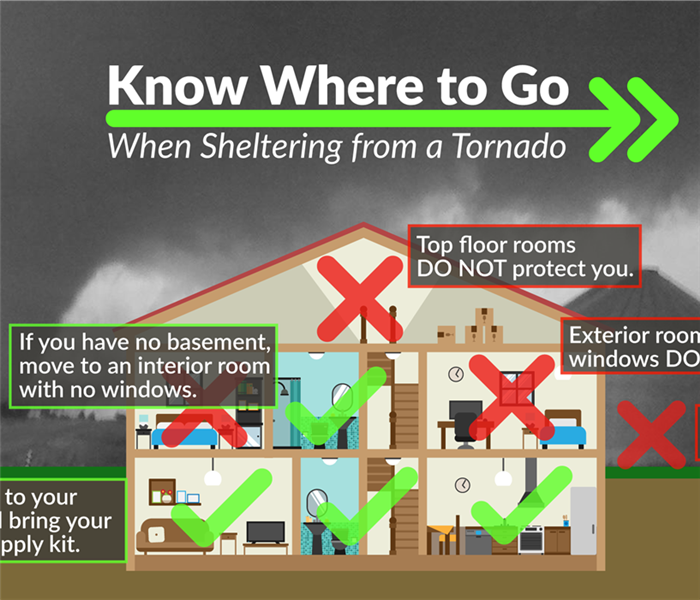 Staying safe during a tornado
Staying safe during a tornado
With all the crazy weather the Midwest has in the spring and summer, it is always better to be prepared and know how to stay safe ahead of time. Below are some tips from the American Red Cross on the best ways to stay safe during a tornado.
Top Tips
Identify a safe place in your home where household members and pets will gather during a tornado: a basement, storm cellar or an interior room on the lowest floor with no windows.
In a high-rise building, pick a hallway in the center of the building. You may not have enough time to go to the lowest floor.
In a mobile home, choose a safe place in a nearby sturdy building. If your mobile home park has a designated shelter, make it your safe place. No mobile home, however it is configured, is safe in a tornado.
Know the Difference between a Tornado Watch and a Tornado Warning!
A tornado WATCH means a tornado is possible.
A tornado WARNING means a tornado is already occurring or will occur soon. GO TO YOUR SAFE PLACE IMMEDIATELY.
Spring Showers...
5/12/2020 (Permalink)
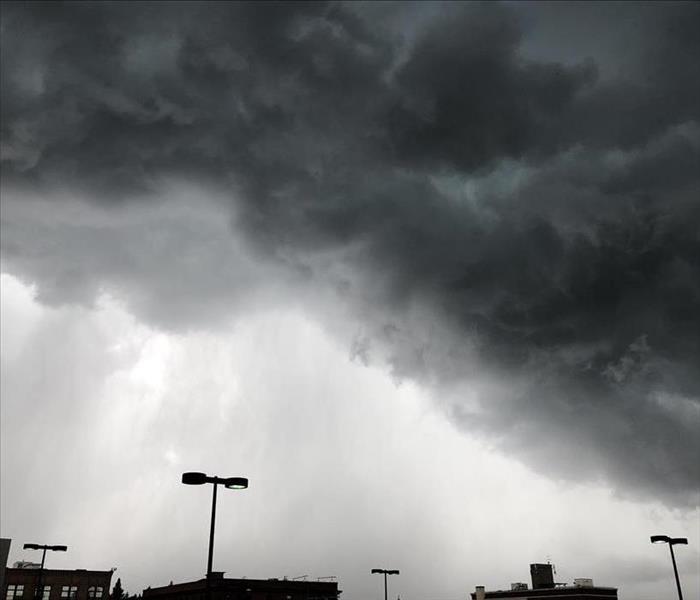 Spring Showers...
Spring Showers...
Spring is the time of year when many things change—including the weather. Temperatures can swing back and forth between hot and cold. Sunny days may be followed by a week of stormy weather. Sometimes extreme weather changes can occur even within the same day.
Thunderstorms cause most of the severe spring weather. They can bring lightning, tornadoes, and flooding. It is important to be prepared for when nature strikes.
Advanced planning for thunderstorms, lightning, tornadoes, and floods requires specific safety precautions. You can follow many of the same steps that you would for all extreme weather events. Keep an emergency kit on hand.
Prepare your family members for the possibility of severe weather. Tell them where to seek appropriate shelter as soon as they are aware of an approaching storm. Practice your emergency plan for every type of severe weather. Show family members where the emergency supplies are stored, and make sure they know how to turn off the water, gas, and electricity in your home.
After the storms if you find you have damage to your home, don't forget SERVPRO of West Topeka is here to help 24/7. We are ready for whatever the weather leaves behind!
Call us today 785-862-0550
In case of emergency...
4/28/2020 (Permalink)
 In case of emergency...
In case of emergency...
This page explains what actions to take when you receive a tornado watch or warning alert from the National Weather Service for your local area and what to do before, during, and after a tornado.
Know your risk
What
A tornado is a violently rotating column of air that extends from a thunderstorm to the ground and is often—although not always—visible as a funnel cloud. Lightning and hail are common in thunderstorms that produce tornadoes. Tornadoes cause extensive damage to structures and disrupt transportation, power, water, gas, communications, and other services in its direct path and in neighboring areas. Related thunderstorms can cause heavy rains, flash flooding, and hail
Where
About 1,200 tornadoes hit the United States every year and every state is at risk. Most tornadoes in the United States occur east of the Rocky Mountains with concentrations in the central and southern plains, the Gulf Coast and Florida.
When
Tornadoes can strike in any season, but occur most often in the spring and summer months. They can occur at all hours of the day and night, but are most likely to occur between 3 p.m. and 9 p.m.
Before a Tornado
Identify safe rooms built to FEMA criteria or ICC500 storm shelters or other potential protective locations in sturdy buildings near your home, work, and other locations you frequent so you have a plan for where you will go quickly for safety when there is a Warning or an approaching tornado.
For schools, malls, and other buildings with long-span roofs or open space plans, or many occupants, ask the building manager to identify the best available refuge.
Build an emergency kit and make a family communications plan.
Listen to NOAA Weather Radio or to commercial radio or television newscasts for the latest information. In any emergency, always listen to the instructions given by local emergency management officials.
Be alert to changing weather conditions. Look for approaching storms.
Look for the following danger signs:
Dark, often greenish sky
Large hail
A large, dark, low-lying cloud (particularly if rotating)
Loud roar, similar to a freight train.
If you see approaching storms or any of the danger signs, be prepared to take shelter immediately.
Tornado Facts
The extent of destruction caused by tornadoes depends on the tornado’s intensity, size, path, time of day, and amount of time it is on the ground. Wind from tornadoes can reach more than 300 miles per hour, and damage paths can be more than 1 mile wide and 50 miles long. Wind from tornadoes can destroy buildings and trees, transform debris into deadly projectiles, and roll vehicles.
They may strike quickly, with little or no warning.
They may appear nearly transparent until dust and debris are picked up or a cloud forms in the funnel.
The average tornado moves Southwest to Northeast, but tornadoes have been known to move in any direction.
Tornadoes can accompany tropical storms and hurricanes as they move onto land.
Waterspouts are tornadoes that form over water.
Know the Terms
Familiarize yourself with these terms to help identify a tornado hazard:
Tornado Watch - Tornadoes are possible. When there is a Watch, move to be near enough to a shelter or sturdy building to be able to get there quickly in a few minutes if there is a Warning or if you see signs of a tornado approaching. Remain alert for approaching storms. Watch the sky and stay tuned to NOAA Weather Radio, commercial radio or television for information.
Tornado Warning - A tornado has been sighted or indicated by weather radar. Take shelter immediately.
During a Tornado
If you are under a tornado warning, seek shelter immediately! Most injuries associated with high winds are from flying debris, so remember to protect your head.
If you are in school, nursing home, hospital, factory, shopping center, high-rise building pre-identified best available refuge then:
Go to a pre-designated area such as a safe room built to FEMA criteria, or a small interior windowless room on the lowest level, below ground in a basement, or storm cellar, is best. (Closet, interior hallway) away from corners, windows, doors, and outside walls. Put as many walls as possible between you and the outside. Get under a sturdy table and cover your head and neck with your arms and cover your body as best you can e.g., with a heavy coat or blankets, pillows. .
In a high-rise building, go to a small interior room or hallway on the lowest floor possible.
Do not open windows.
A sturdy structure (e.g. residence, small building) , school, nursing home, hospital, factory, shopping center, high-rise building)
A manufactured home or office then:
Get out immediately and go to a pre-identified location such as the lowest floor of a sturdy, nearby building or a storm shelter. Mobile homes, even if tied down, do not offer protection from tornadoes.
The outside with no shelter then:
If you are not in a sturdy building, there is no single research-based recommendation for what last-resort action to take because many factors can affect your decision. Possible actions include:
Immediately get into a vehicle, buckle your seat belt and try to drive to the closest sturdy shelter. If your vehicle is hit by flying debris while you are driving, pull over and park.
Take cover in a stationary vehicle. Put the seat belt on and cover your head with your arms and a blanket, coat or other cushion if possible.
In all situations:
Do not get under an overpass or bridge. You are safer in a low, flat location.
Never try to outrun a tornado in urban or congested areas in a car or truck. Instead, leave the vehicle immediately for protection in a sturdy building. .
Outdoor areas are not protected from flying debris. Flying debris from tornadoes causes most fatalities and injuries.
After a Tornado
If you are trapped, do not move about or kick up dust. Tap on a pipe or wall or use a whistle, if you have one, so that rescuers can locate you.
Listen to local officials for updates and instructions.
Check-in with family and friends by texting or using social media.
Watch out for debris and downed power lines.
Stay out of damaged buildings and homes until local authorities indicate it is safe.
Use extreme caution during post-disaster clean-up of buildings and around debris. Do not attempt to remove heavy debris by yourself. Wear protective clothing, including a long-sleeved shirt, long pants, work gloves, and sturdy, thick-soled shoes during clean-up.
Photograph the damage to your property in order to assist in filing an insurance claim.
Do what you can to prevent further damage to your property, (e.g., putting a tarp on a damaged roof), as insurance may not cover additional damage that occurs after the storm.
If your home is without power, use flashlights or battery-powered lanterns rather than candles to prevent accidental fires.
Kansas weather can be unpredictable! Be informed & stay safe!
If tragedy strikes remember, SERVPRO of West Topeka is always here to help!
785-862-0550
Staying Safe During Tornado Season
4/15/2020 (Permalink)
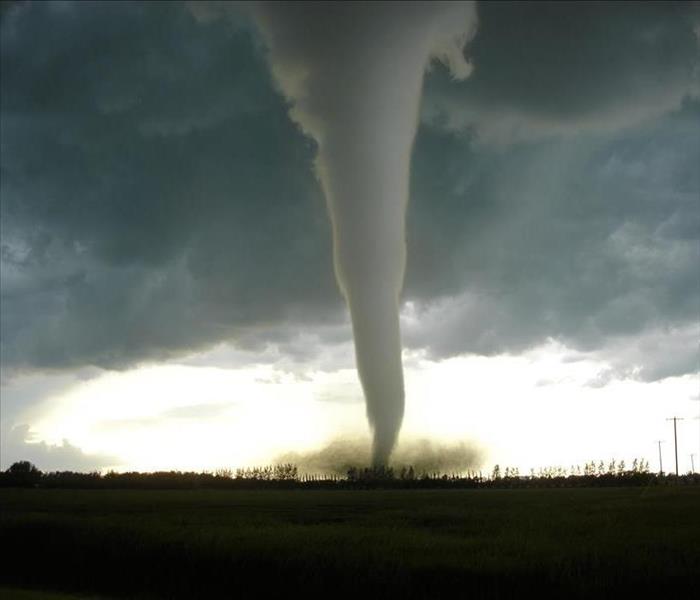 Staying Safe During Tornado Season
Staying Safe During Tornado Season
This page explains what actions to take when you receive a tornado watch or warning alert from the National Weather Service for your local area and what to do before, during, and after a tornado.
What is a tornado?
A tornado is a violently rotating column of air that extends from a thunderstorm to the ground and is often—although not always—visible as a funnel cloud. Lightning and hail are common in thunderstorms that produce tornadoes. Tornadoes cause extensive damage to structures and disrupt transportation, power, water, gas, communications, and other services in its direct path and in neighboring areas. Related thunderstorms can cause heavy rains, flash flooding, and hail
Where
About 1,200 tornadoes hit the United States every year and every state is at risk. Most tornadoes in the United States occur east of the Rocky Mountains with concentrations in the central and southern plains, the Gulf Coast and Florida.
When
Tornadoes can strike in any season, but occur most often in the spring and summer months. They can occur at all hours of the day and night, but are most likely to occur between 3 p.m. and 9 p.m.
Before a Tornado
Identify safe rooms built to FEMA criteria or ICC500 storm shelters or other potential protective locations in sturdy buildings near your home, work, and other locations you frequent so you have a plan for where you will go quickly for safety when there is a Warning or an approaching tornado.
For schools, malls, and other buildings with long-span roofs or open space plans, or many occupants, ask the building manager to identify the best available refuge.
Build an emergency kit and make a family communications plan.
Listen to NOAA Weather Radio or to commercial radio or television newscasts for the latest information. In any emergency, always listen to the instructions given by local emergency management officials.
Be alert to changing weather conditions. Look for approaching storms.
Look for the following danger signs:
Dark, often greenish sky
Large hail
A large, dark, low-lying cloud (particularly if rotating)
Loud roar, similar to a freight train.
If you see approaching storms or any of the danger signs, be prepared to take shelter immediately.
Tornado Facts
The extent of destruction caused by tornadoes depends on the tornado’s intensity, size, path, time of day, and amount of time it is on the ground. Wind from tornadoes can reach more than 300 miles per hour, and damage paths can be more than 1 mile wide and 50 miles long. Wind from tornadoes can destroy buildings and trees, transform debris into deadly projectiles, and roll vehicles.
They may strike quickly, with little or no warning.
They may appear nearly transparent until dust and debris are picked up or a cloud forms in the funnel.
The average tornado moves Southwest to Northeast, but tornadoes have been known to move in any direction.
Tornadoes can accompany tropical storms and hurricanes as they move onto land.
Waterspouts are tornadoes that form over water.
Know the Terms
Familiarize yourself with these terms to help identify a tornado hazard:
Tornado Watch - Tornadoes are possible. When there is a Watch, move to be near enough to a shelter or sturdy building to be able to get there quickly in a few minutes if there is a Warning or if you see signs of a tornado approaching. Remain alert for approaching storms. Watch the sky and stay tuned to NOAA Weather Radio, commercial radio or television for information.
Tornado Warning - A tornado has been sighted or indicated by weather radar. Take shelter immediately.
During a Tornado
If you are under a tornado warning, seek shelter immediately! Most injuries associated with high winds are from flying debris, so remember to protect your head.
If you are in school, nursing home, hospital, factory, shopping center, high-rise building pre-identified best available refuge then:
Go to a pre-designated area such as a safe room built to FEMA criteria, or a small interior windowless room on the lowest level, below ground in a basement, or storm cellar, is best. (Closet, interior hallway) away from corners, windows, doors, and outside walls. Put as many walls as possible between you and the outside. Get under a sturdy table and cover your head and neck with your arms and cover your body as best you can e.g., with a heavy coat or blankets, pillows. .
In a high-rise building, go to a small interior room or hallway on the lowest floor possible.
Do not open windows.
A sturdy structure (e.g. residence, small building) , school, nursing home, hospital, factory, shopping center, high-rise building)
A manufactured home or office then:
Get out immediately and go to a pre-identified location such as the lowest floor of a sturdy, nearby building or a storm shelter. Mobile homes, even if tied down, do not offer protection from tornadoes.
The outside with no shelter then:
If you are not in a sturdy building, there is no single research-based recommendation for what last-resort action to take because many factors can affect your decision. Possible actions include:
Immediately get into a vehicle, buckle your seat belt and try to drive to the closest sturdy shelter. If your vehicle is hit by flying debris while you are driving, pull over and park.
Take cover in a stationary vehicle. Put the seat belt on and cover your head with your arms and a blanket, coat or other cushion if possible.
In all situations:
Do not get under an overpass or bridge. You are safer in a low, flat location.
Never try to outrun a tornado in urban or congested areas in a car or truck. Instead, leave the vehicle immediately for protection in a sturdy building. .
Outdoor areas are not protected from flying debris. Flying debris from tornadoes causes most fatalities and injuries.
After a Tornado
If you are trapped, do not move about or kick up dust. Tap on a pipe or wall or use a whistle, if you have one, so that rescuers can locate you.
Listen to local officials for updates and instructions.
Check-in with family and friends by texting or using social media.
Watch out for debris and downed power lines.
Stay out of damaged buildings and homes until local authorities indicate it is safe.
Use extreme caution during post-disaster clean-up of buildings and around debris. Do not attempt to remove heavy debris by yourself. Wear protective clothing, including a long-sleeved shirt, long pants, work gloves, and sturdy, thick-soled shoes during clean-up.
Photograph the damage to your property in order to assist in filing an insurance claim.
Do what you can to prevent further damage to your property, (e.g., putting a tarp on a damaged roof), as insurance may not cover additional damage that occurs after the storm.
If your home is without power, use flashlights or battery-powered lanterns rather than candles to prevent accidental fires.
Kansas weather can be unpredictable! Be informed & stay safe!
If tragedy strikes remember, SERVPRO of West Topeka is always here to help!
785-862-0550
Staying safe during a water damage
4/15/2020 (Permalink)
 Staying safe during a water damage
Staying safe during a water damage
SERVPRO of West Topeka knows that in these uncertain times some things always remain the same. And one of those things is unexpected damage to your home. And whether that damage is from a rain storm, a tornado, or a broken refrigerator line, SERVPRO of West Topeka is here to help! If you experience a water loss or a flood, one of the most important things you can do is to identify potential hazards as soon as possible.
Here are a few to remember:
Ceiling: If water damage has occurred to your roof/ceiling, the ceiling/roof could potentially be unstable
Electrical shock hazards: Lights can indicate if the power is still on and if the area is dangerous. DO NOT touch any sockets or switches to check if the lights are on
Contaminated water
Hidden hazards in the water
Tornado Safety
5/30/2019 (Permalink)
With all the crazy weather the Midwest has been having this spring it is always better to be prepared and know how to stay safe ahead of time. Below are some tips from the American Red Cross on the best ways to stay safe during a tornado.
Top Tips
- Identify a safe place in your home where household members and pets will gather during a tornado: a basement, storm cellar or an interior room on the lowest floor with no windows.
- In a high-rise building, pick a hallway in the center of the building. You may not have enough time to go to the lowest floor.
- In a mobile home, choose a safe place in a nearby sturdy building. If your mobile home park has a designated shelter, make it your safe place. No mobile home, however it is configured, is safe in a tornado.
Know the Difference between a Tornado Watch and a Tornado Warning!
- A tornado WATCH means a tornado is possible.
- A tornado WARNING means a tornado is already occurring or will occur soon. GO TO YOUR SAFE PLACE IMMEDIATELY.
Is it dry yet?
5/23/2019 (Permalink)
As rain continues to be forecast for the foreseeable future (or at least what we can see thru the waterfall of rain) and wait lists for water damage service get longer and longer knowing how to speed up the drying process and keep your belongings safe from damage is a must!
First of all Safety First!
If there is standing water, or any water, in your basement make sure you are wearing some sort of foot gear that will protect your feet from getting soaked.
NEVER plug in any sort of equipment near water or in to a damp socket!
Protect Your Belongings!
It is always a good idea to have any boxes or contents in your basement off the floor and up on pallets at all times in case of a flooded basement but if you don't or if you have a finished basement one of the first things you will want to do is move all (or as much as you can) of your contents and furniture away from the affected area. If you cannot get furniture out of the area place it up on foam blocks or at least put some sort of non permeable barrier in between the furniture and floor to help prevent further damage and staining.
Beginning the Drying Process!
Using a shop vac, plugged in to a power supply that has not been affected by the water, start to suck up the incoming water.
During normal conditions SERVPRO would happily perform all of the above for any homeowner but when extreme weather hits and thousands of people have flooded basements, we want to try and help as many people as we can. By performing the above tasks you can insure less loss until we can get there to help!
Rain, rain, everywhere....Surviving Spring in the Midwest
5/9/2019 (Permalink)
Spring is the time of year when many things change—including the weather. Temperatures can swing back and forth between balmy and frigid. Sunny days may be followed by a week of stormy weather. Sometimes extreme weather changes can occur even within the same day. Mark Twain once said, "In the spring I have counted one hundred and thirty-six kinds of weather inside of four and twenty hours."
Thunderstorms cause most of the severe spring weather. They can bring lightning, tornadoes, and flooding. Whenever warm, moist air collides with cool, dry air, thunderstorms can occur. For much of the world, this happens in spring and summer.
Reduce injury risk and plan ahead
Because spring weather is so unpredictable, you may be unprepared when severe weather hits—particularly if you live in a region that does not often experience thunderstorms, tornadoes, or flooding. And when severe weather hits unexpectedly, the risk of injury and death increases. So planning ahead makes sense; prepare for storms, floods, and tornadoes as if you know in advance they are coming, because in the spring, they very likely will.
Advance planning for thunderstorms, lightning, tornadoes, and floods requires specific safety precautions. You can follow many of the same steps that you would for all extreme weather events. Keep an emergency kit on hand. Some items to include are:
- A battery-operated flashlight, a battery-operated NOAA Weather Radio, and extra batteries for both
- An emergency evacuation or shelter plan, including a map of your home and, for every type of severe weather emergency, routes to safety from each room
- A list of important personal information, including:
- telephone numbers of neighbors, family, and friends
- insurance and property information
- telephone numbers of utility companies
- medical information
- According to the American Red Cross a first aid kit may include:
- non-latex gloves
- assortment of adhesive bandages
- antibiotic ointment
- sterile gauze pads in assorted sizes
- absorbent compress dressings
- tweezers
- scissors
- adhesive cloth tape
- aspirin packets (81 mg each)
- first aid instruction booklet
(NOTE: Customize your first aid kit to meet your individual and family needs.)
- A 3–5 day supply of bottled water and nonperishable food
- Personal hygiene items
- Blankets or sleeping bags
- An emergency kit in your car
Prepare your family members for the possibility of severe weather. Tell them where to seek appropriate shelter as soon as they are aware of an approaching storm. Practice your emergency plan for every type of severe weather. Show family members where the emergency supplies are stored, and make sure they know how to turn off the water, gas, and electricity in your home.
Often by the time we are aware of an approaching storm, we have little if any time to prepare for it. But we do know that when spring arrives, thunderstorms, tornadoes, and floods are real possibilities. So why not take the surprise factor out of severe weather and prepare yourself, your family, and your home? If thunderstorms, tornadoes, and floods do occur, you'll be ready for them.
https://www.cdc.gov/features/springweather/
After the storms if you find you have damage to your home, don't forget SERVPRO of West Topeka is here to help 24/7. We are ready for whatever the weather leaves behind!
Call us today 785-862-0550
Knowing what to do in case of emergency!
4/12/2019 (Permalink)
This page explains what actions to take when you receive a tornado watch or warning alert from the National Weather Service for your local area and what to do before, during, and after a tornado.
Know your risk
What
A tornado is a violently rotating column of air that extends from a thunderstorm to the ground and is often—although not always—visible as a funnel cloud. Lightning and hail are common in thunderstorms that produce tornadoes. Tornadoes cause extensive damage to structures and disrupt transportation, power, water, gas, communications, and other services in its direct path and in neighboring areas. Related thunderstorms can cause heavy rains, flash flooding, and hail
Where
About 1,200 tornadoes hit the United States every year and every state is at risk. Most tornadoes in the United States occur east of the Rocky Mountains with concentrations in the central and southern plains, the Gulf Coast and Florida.
When
Tornadoes can strike in any season, but occur most often in the spring and summer months. They can occur at all hours of the day and night, but are most likely to occur between 3 p.m. and 9 p.m.
Before a Tornado
Identify safe rooms built to FEMA criteria or ICC500 storm shelters or other potential protective locations in sturdy buildings near your home, work, and other locations you frequent so you have a plan for where you will go quickly for safety when there is a Warning or an approaching tornado.
For schools, malls, and other buildings with long-span roofs or open space plans, or many occupants, ask the building manager to identify the best available refuge.
Build an emergency kit and make a family communications plan.
Listen to NOAA Weather Radio or to commercial radio or television newscasts for the latest information. In any emergency, always listen to the instructions given by local emergency management officials.
Be alert to changing weather conditions. Look for approaching storms.
Look for the following danger signs:
Dark, often greenish sky
Large hail
A large, dark, low-lying cloud (particularly if rotating)
Loud roar, similar to a freight train.
If you see approaching storms or any of the danger signs, be prepared to take shelter immediately.
Tornado Facts
The extent of destruction caused by tornadoes depends on the tornado’s intensity, size, path, time of day, and amount of time it is on the ground. Wind from tornadoes can reach more than 300 miles per hour, and damage paths can be more than 1 mile wide and 50 miles long. Wind from tornadoes can destroy buildings and trees, transform debris into deadly projectiles, and roll vehicles.
They may strike quickly, with little or no warning.
They may appear nearly transparent until dust and debris are picked up or a cloud forms in the funnel.
The average tornado moves Southwest to Northeast, but tornadoes have been known to move in any direction.
Tornadoes can accompany tropical storms and hurricanes as they move onto land.
Waterspouts are tornadoes that form over water.
Know the Terms
Familiarize yourself with these terms to help identify a tornado hazard:
Tornado Watch - Tornadoes are possible. When there is a Watch, move to be near enough to a shelter or sturdy building to be able to get there quickly in a few minutes if there is a Warning or if you see signs of a tornado approaching. Remain alert for approaching storms. Watch the sky and stay tuned to NOAA Weather Radio, commercial radio or television for information.
Tornado Warning - A tornado has been sighted or indicated by weather radar. Take shelter immediately.
During a Tornado
If you are under a tornado warning, seek shelter immediately! Most injuries associated with high winds are from flying debris, so remember to protect your head.
If you are in school, nursing home, hospital, factory, shopping center, high-rise building pre-identified best available refuge then:
Go to a pre-designated area such as a safe room built to FEMA criteria, or a small interior windowless room on the lowest level, below ground in a basement, or storm cellar, is best. (Closet, interior hallway) away from corners, windows, doors, and outside walls. Put as many walls as possible between you and the outside. Get under a sturdy table and cover your head and neck with your arms and cover your body as best you can e.g., with a heavy coat or blankets, pillows. .
In a high-rise building, go to a small interior room or hallway on the lowest floor possible.
Do not open windows.
A sturdy structure (e.g. residence, small building) , school, nursing home, hospital, factory, shopping center, high-rise building)
A manufactured home or office then:
Get out immediately and go to a pre-identified location such as the lowest floor of a sturdy, nearby building or a storm shelter. Mobile homes, even if tied down, do not offer protection from tornadoes.
The outside with no shelter then:
If you are not in a sturdy building, there is no single research-based recommendation for what last-resort action to take because many factors can affect your decision. Possible actions include:
Immediately get into a vehicle, buckle your seat belt and try to drive to the closest sturdy shelter. If your vehicle is hit by flying debris while you are driving, pull over and park.
Take cover in a stationary vehicle. Put the seat belt on and cover your head with your arms and a blanket, coat or other cushion if possible.
In all situations:
Do not get under an overpass or bridge. You are safer in a low, flat location.
Never try to outrun a tornado in urban or congested areas in a car or truck. Instead, leave the vehicle immediately for protection in a sturdy building. .
Outdoor areas are not protected from flying debris. Flying debris from tornadoes causes most fatalities and injuries.
After a Tornado
If you are trapped, do not move about or kick up dust. Tap on a pipe or wall or use a whistle, if you have one, so that rescuers can locate you.
Listen to local officials for updates and instructions.
Check-in with family and friends by texting or using social media.
Watch out for debris and downed power lines.
Stay out of damaged buildings and homes until local authorities indicate it is safe.
Use extreme caution during post-disaster clean-up of buildings and around debris. Do not attempt to remove heavy debris by yourself. Wear protective clothing, including a long-sleeved shirt, long pants, work gloves, and sturdy, thick-soled shoes during clean-up.
Photograph the damage to your property in order to assist in filing an insurance claim.
Do what you can to prevent further damage to your property, (e.g., putting a tarp on a damaged roof), as insurance may not cover additional damage that occurs after the storm.
If your home is without power, use flashlights or battery-powered lanterns rather than candles to prevent accidental fires.
Kansas weather can be unpredictable! Be informed & stay safe!
If tragedy strikes remember, SERVPRO of W. Topeka is always here to help!
785-862-0550
Spring Weather Can Be Unpredictable in Topeka
5/9/2018 (Permalink)
 Often by the time we are aware of an approaching storm, we have little to no time to prepare for it.
Often by the time we are aware of an approaching storm, we have little to no time to prepare for it.
Spring is the time of year when many things change—including the weather. Temperatures can swing back and forth between balmy and frigid. Sunny days may be followed by a week of stormy weather. Sometimes extreme weather changes can occur even within the same day. Mark Twain once said, "In the spring I have counted one hundred and thirty-six kinds of weather inside of four and twenty hours."
Thunderstorms cause most of the severe spring weather. They can bring lightning, tornadoes, and flooding. Whenever warm, moist air collides with cool, dry air, thunderstorms can occur. For much of the world, this happens in spring and summer.
Reduce injury risk and plan ahead
Because spring weather is so unpredictable, you may be unprepared when severe weather hits—particularly if you live in a region that does not often experience thunderstorms, tornadoes, or flooding. And when severe weather hits unexpectedly, the risk of injury and death increases. So planning ahead makes sense; prepare for storms, floods, and tornadoes as if you know in advance they are coming, because in the spring, they very likely will.
Advance planning for thunderstorms, lightning, tornadoes, and floods requires specific safety precautions. You can follow many of the same steps that you would for all extreme weather events. Keep an emergency kit on hand. Some items to include are:
- A battery-operated flashlight, a battery-operated NOAA Weather Radio, and extra batteries for both
- An emergency evacuation or shelter plan, including a map of your home and, for every type of severe weather emergency, routes to safety from each room
- A list of important personal information, including:
?telephone numbers of neighbors, family, and friends
?insurance and property information
?telephone numbers of utility companies
?medical information
- According to the American Red Cross a first aid kit may include:
?non-latex gloves
?assortment of adhesive bandages
?antibiotic ointment
?sterile gauze pads in assorted sizes
?absorbent compress dressings
?tweezers
?scissors
?adhesive cloth tape
?aspirin packets (81 mg each)
?first aid instruction booklet
(NOTE: Customize your first aid kit to meet your individual and family needs.)
- A 3–5 day supply of bottled water and nonperishable food
- Personal hygiene items
- Blankets or sleeping bags
- An emergency kit in your car
Prepare your family members for the possibility of severe weather. Tell them where to seek appropriate shelter as soon as they are aware of an approaching storm. Practice your emergency plan for every type of severe weather. Show family members where the emergency supplies are stored, and make sure they know how to turn off the water, gas, and electricity in your home.
Often by the time we are aware of an approaching storm, we have little if any time to prepare for it. But we do know that when spring arrives, thunderstorms, tornadoes, and floods are real possibilities. So why not take the surprise factor out of severe weather and prepare yourself, your family, and your home? If thunderstorms, tornadoes, and floods do occur, you'll be ready for them.
https://www.cdc.gov/features/springweather/
After the storms if you find you have damage to your home, don't forget SERVPRO of W. Topeka is here to help 24/7. We are ready for whatever the weather leaves behind!
Call us today 785-862-0550
Don't get swept away in this Kansas weather!
4/5/2018 (Permalink)
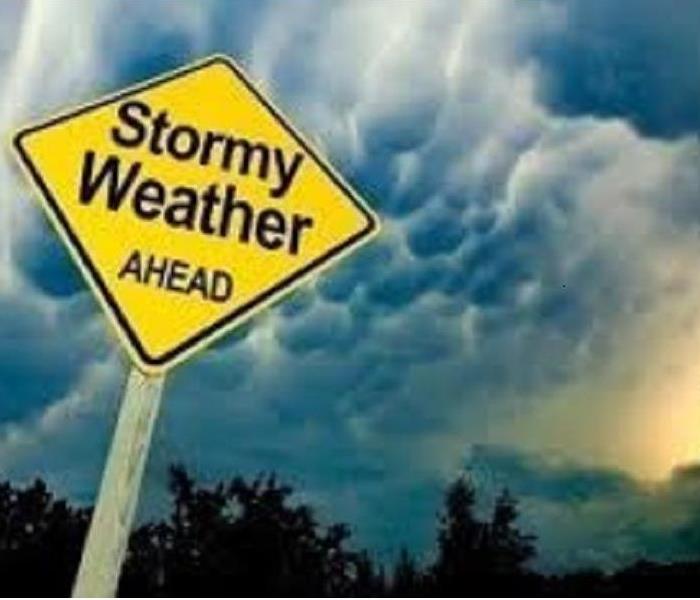 Be prepared for any kind of weather!
Be prepared for any kind of weather!
We all know how crazy the weather in Kansas can be in the spring time. There is never a better time to be prepared than before the storm hits! Be sure you know the difference between a watch and a warning.
Make sure your prepared with these tips from ready.gov
Flood Watch = “Be Aware.” Conditions are right for flooding to occur in your area.
Steps to Take
- Turn on your TV/radio. You will receive the latest weather updates and emergency instructions.
- Know where to go. You may need to reach higher ground quickly and on foot.
- Build or restock your emergency preparedness kit. Include a flashlight, batteries, cash, and first aid supplies.
Prepare Your Home
- Bring in outdoor furniture and move important indoor items to the highest possible floor. This will help protect them from flood damage.
- Disconnect electrical appliances and do not touch electrical equipment if you are wet or standing in water. You could be electrocuted.
- If instructed, turn off your gas and electricity at the main switch or valve. This helps prevent fires and explosions.
Flood Warning = "Take Action!" Flooding is either happening or will happen shortly.
Steps to Take
- Move immediately to higher ground or stay on high ground.
- Avoid walking or driving through flood waters. Turn Around, Don’t Drown! Just 6 inches of moving water can knock you down and 2 feet of water can sweep your vehicle away.
After the water recedes and your home has sustained damage don’t forget SERVPRO of West Topeka is always here to help!
Call us at 785-862-0550
About SERVPRO of West Topeka
SERVPRO of West Topeka specializes in the cleanup and restoration of residential and commercial property after a fire, smoke or water damage event. Our staff is highly trained in property damage restoration. From initial and ongoing training at SERVPRO’s corporate training facility to regular IICRC-industry certification, rest assured our staff is equipped with the knowledge to restore your property
Tornadoes ~ Are you Prepared?
3/13/2018 (Permalink)
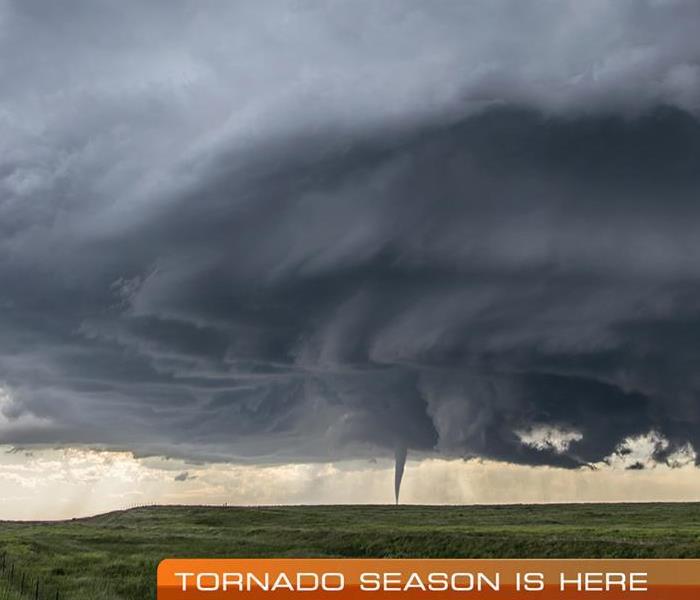 Tornado season will be here soon! Be Prepared!
Tornado season will be here soon! Be Prepared!
This page explains what actions to take when you receive a tornado watch or warning alert from the National Weather Service for your local area and what to do before, during, and after a tornado.
Know your risk
What
A tornado is a violently rotating column of air that extends from a thunderstorm to the ground and is often—although not always—visible as a funnel cloud. Lightning and hail are common in thunderstorms that produce tornadoes. Tornadoes cause extensive damage to structures and disrupt transportation, power, water, gas, communications, and other services in its direct path and in neighboring areas. Related thunderstorms can cause heavy rains, flash flooding, and hail
Where
About 1,200 tornadoes hit the United States every year and every state is at risk. Most tornadoes in the United States occur east of the Rocky Mountains with concentrations in the central and southern plains, the Gulf Coast and Florida.
When
Tornadoes can strike in any season, but occur most often in the spring and summer months. They can occur at all hours of the day and night, but are most likely to occur between 3 p.m. and 9 p.m.
Before a Tornado
- Identify safe rooms built to FEMA criteria or ICC500 storm shelters or other potential protective locations in sturdy buildings near your home, work, and other locations you frequent so you have a plan for where you will go quickly for safety when there is a Warning or an approaching tornado.
- For schools, malls, and other buildings with long-span roofs or open space plans, or many occupants, ask the building manager to identify the best available refuge.
- Build an emergency kit and make a family communications plan.
- Listen to NOAA Weather Radio or to commercial radio or television newscasts for the latest information. In any emergency, always listen to the instructions given by local emergency management officials.
- Be alert to changing weather conditions. Look for approaching storms.
- Look for the following danger signs:
- Dark, often greenish sky
- Large hail
- A large, dark, low-lying cloud (particularly if rotating)
- Loud roar, similar to a freight train.
- If you see approaching storms or any of the danger signs, be prepared to take shelter immediately.
Tornado Facts
The extent of destruction caused by tornadoes depends on the tornado’s intensity, size, path, time of day, and amount of time it is on the ground. Wind from tornadoes can reach more than 300 miles per hour, and damage paths can be more than 1 mile wide and 50 miles long. Wind from tornadoes can destroy buildings and trees, transform debris into deadly projectiles, and roll vehicles.
- They may strike quickly, with little or no warning.
- They may appear nearly transparent until dust and debris are picked up or a cloud forms in the funnel.
- The average tornado moves Southwest to Northeast, but tornadoes have been known to move in any direction.
- Tornadoes can accompany tropical storms and hurricanes as they move onto land.
- Waterspouts are tornadoes that form over water.
Know the Terms
Familiarize yourself with these terms to help identify a tornado hazard:
- Tornado Watch - Tornadoes are possible. When there is a Watch, move to be near enough to a shelter or sturdy building to be able to get there quickly in a few minutes if there is a Warning or if you see signs of a tornado approaching. Remain alert for approaching storms. Watch the sky and stay tuned to NOAA Weather Radio, commercial radio or television for information.
- Tornado Warning - A tornado has been sighted or indicated by weather radar. Take shelter immediately.
During a Tornado
If you are under a tornado warning, seek shelter immediately! Most injuries associated with high winds are from flying debris, so remember to protect your head.
If you are in school, nursing home, hospital, factory, shopping center, high-rise building pre-identified best available refuge then:
- Go to a pre-designated area such as a safe room built to FEMA criteria, or a small interior windowless room on the lowest level, below ground in a basement, or storm cellar, is best. (Closet, interior hallway) away from corners, windows, doors, and outside walls. Put as many walls as possible between you and the outside. Get under a sturdy table and cover your head and neck with your arms and cover your body as best you can e.g., with a heavy coat or blankets, pillows. .
- In a high-rise building, go to a small interior room or hallway on the lowest floor possible.
- Do not open windows.
- A sturdy structure (e.g. residence, small building) , school, nursing home, hospital, factory, shopping center, high-rise building)
A manufactured home or office then:
Get out immediately and go to a pre-identified location such as the lowest floor of a sturdy, nearby building or a storm shelter. Mobile homes, even if tied down, do not offer protection from tornadoes.
The outside with no shelter then:
- If you are not in a sturdy building, there is no single research-based recommendation for what last-resort action to take because many factors can affect your decision. Possible actions include:
- Immediately get into a vehicle, buckle your seat belt and try to drive to the closest sturdy shelter. If your vehicle is hit by flying debris while you are driving, pull over and park.
- Take cover in a stationary vehicle. Put the seat belt on and cover your head with your arms and a blanket, coat or other cushion if possible.
- In all situations:
- Do not get under an overpass or bridge. You are safer in a low, flat location.
- Never try to outrun a tornado in urban or congested areas in a car or truck. Instead, leave the vehicle immediately for protection in a sturdy building. .
- Outdoor areas are not protected from flying debris. Flying debris from tornadoes causes most fatalities and injuries.
After a Tornado
- If you are trapped, do not move about or kick up dust. Tap on a pipe or wall or use a whistle, if you have one, so that rescuers can locate you.
- Listen to local officials for updates and instructions.
- Check-in with family and friends by texting or using social media.
- Watch out for debris and downed power lines.
- Stay out of damaged buildings and homes until local authorities indicate it is safe.
- Use extreme caution during post-disaster clean-up of buildings and around debris. Do not attempt to remove heavy debris by yourself. Wear protective clothing, including a long-sleeved shirt, long pants, work gloves, and sturdy, thick-soled shoes during clean-up.
- Photograph the damage to your property in order to assist in filing an insurance claim.
- Do what you can to prevent further damage to your property, (e.g., putting a tarp on a damaged roof), as insurance may not cover additional damage that occurs after the storm.
- If your home is without power, use flashlights or battery-powered lanterns rather than candles to prevent accidental fires.
Kansas weather can be unpredictable! Be informed & stay safe!
If tragedy strikes remember, SERVPRO of W. Topeka is always here to help!
785-862-0550
Spring Weather Ahead, Don't Get Swept Away!
3/9/2018 (Permalink)
We all know how crazy the weather in Kansas can be in the spring time. There is never a better time to be prepared than before the storm hits! Be sure you know the difference between a watch and a warning.
Make sure your prepared with these tips from ready.gov
Flood Watch = “Be Aware.” Conditions are right for flooding to occur in your area.
Steps to Take
- Turn on your TV/radio. You will receive the latest weather updates and emergency instructions.
- Know where to go. You may need to reach higher ground quickly and on foot.
- Build or restock your emergency preparedness kit. Include a flashlight, batteries, cash, and first aid supplies.
Prepare Your Home
- Bring in outdoor furniture and move important indoor items to the highest possible floor. This will help protect them from flood damage.
- Disconnect electrical appliances and do not touch electrical equipment if you are wet or standing in water. You could be electrocuted.
- If instructed, turn off your gas and electricity at the main switch or valve. This helps prevent fires and explosions.
Flood Warning = "Take Action!" Flooding is either happening or will happen shortly.
Steps to Take
- Move immediately to higher ground or stay on high ground.
- Avoid walking or driving through flood waters. Turn Around, Don’t Drown! Just 6 inches of moving water can knock you down and 2 feet of water can sweep your vehicle away.
After the water recedes and your home has sustained damage don’t forget SERVPRO of West Topeka is always here to help!
Call us at 785-862-0550
About SERVPRO of West Topeka
SERVPRO of West Topeka specializes in the cleanup and restoration of residential and commercial property after a fire, smoke or water damage event. Our staff is highly trained in property damage restoration. From initial and ongoing training at SERVPRO’s corporate training facility to regular IICRC-industry certification, rest assured our staff is equipped with the knowledge to restore your property

 24/7 Emergency Service
24/7 Emergency Service























